
7 Steps for Writing an Essay Plan
Have you ever started writing an essay then realized you have run out of ideas to talk about?
This can make you feel deflated and you start to hate your essay!

The best way to avoid this mid-essay disaster is to plan ahead: you need to write an Essay Plan!
Essay planning is one of the most important skills I teach my students. When I have one-to-one tutorials with my students, I always send them off with an essay plan and clear goals about what to write.
Essay Planning isn’t as dull as you think. In fact, it really does only take a short amount of time and can make you feel oh so relieved that you know what you’re doing!
Here’s my 7-Step method that I encourage you to use for your next essay:
The 7-Step Guide on How to write an Essay Plan
- Figure out your Essay Topic (5 minutes)
- Gather your Sources and take Quick Notes (20 minutes)
- Brainstorm using a Mind-Map (10 minutes)
- Arrange your Topics (2 minutes)
- Write your topic Sentences (5 minutes)
- Write a No-Pressure Draft in 3 Hours (3 hours)
- Edit your Draft Once every Few Days until Submission (30 minutes)
I’ve been using this 7-Step essay planning strategy since I was in my undergraduate degree. Now, I’ve completed a PhD and written over 20 academic journal articles and dozens of blog posts using this method – and it still works!
Let’s go through my 7 steps for how to write an essay plan.
Prefer to Watch than Read? Here’s our video on writing an Essay Plan.
how to write an essay plan
1. figure out your essay topic. here’s how..
Where did your teacher provide you with your assessment details?
Find it. This is where you begin.
Now, far, far, far too many students end up writing essays that aren’t relevant to the essay question given to you by your teacher. So print out your essay question and any other advice or guidelines provided by your teacher.
Here’s some things that your assessment details page might include:
- The essay question;
- The marking criteria;
- Suggested sources to read;
- Some background information on the topic
The essay question is really important. Once you’ve printed it I want you to do one thing:
Highlight the key phrases in the essay question.
Here’s some essay questions and the key phrases you’d want to highlight:
This strategy helps you to hone in on exactly what you want to talk about. These are the key phrases you’re going to use frequently in your writing and use when you look for sources to cite in your essay!
The other top thing to look at is the marking criteria. Some teachers don’t provide this, but if they do then make sure you pay attention to the marking criteria !
Here’s an example of a marking criteria sheet:
Sample Essay Topic: Is Climate Change the Greatest Moral Challenge of our Generation?
Now, if you have a marking criteria you really need to pay attention to this. You have to make sure you’ve ticked off all the key criteria that you will be marked on. For the example above, your essay is going to have to make sure it:
- Takes a position about whether climate change is a serious challenge for human kind;
- Discusses multiple different people’s views on the topic;
- Explores examples and case studies (‘practical situations’);
- Uses referencing to back up your points.
The reason you need to be really careful to pay attention to this marking criteria is because it is your cheat sheet: it tells you what to talk about!
Step 1 only takes you five minutes and helps you to clearly clarify what you’re going to be talking about! Now your mind is tuned in and you can start doing some preliminary research.
2. Gather your Sources and take Quick Notes. Here’s how.
Now that you know what your focus is, you can start finding some information to discuss. You don’t want to just write things from the top of your head. If you want top marks, you want some deep, detailed and specific pieces of information.
Fortunately, your teacher has probably made this easy for you.
The top source for finding information will be the resources your teacher provided. These resources were hand picked by your teacher because they believed these were the best sources available our there on the topic. Here are the most common resources teachers provide:
- Lecture Slides;
- Assigned Readings.
The lecture slides are one of the best resources for you to access. Lecture slides are usually provided online for you. Download them, save them on your computer, and dig them up when it’s time to write the essay plan.
Find the lecture slides most relevant to your topic. To take the example of our climate change essay, maybe climate change is only discussed in three of the weeks in your course. Those are the three weeks’ lecture slides you want to hone-in on.
Flick through those lecture slides and take quick notes on a piece of paper – what are the most important topics and statistics that are relevant to your essay question?
Now, move on to the assigned readings . Your teacher will have selected some readings for you to do for homework through the semester. They may be eBooks, Textbooks or Journal Articles.
These assigned readings were assigned for a reason: because they have very important information to read ! Scan through them and see if there’s any more points you can add to your list of statistics and key ideas to discuss.
Next, try to find a few more sources using Google Scholar. This is a great resource for finding more academic articles that you can read to find even more details and ideas to add to your essay.
Here’s my notes that I researched for the essay question “Is Climate Change the Greatest Moral Challenge of our Generation?” As you can see, it doesn’t have to be beautiful #Studygram notes! It’s just rough notes to get all the important information down:

Once you’ve read the assigned lecture slides and readings, you should have a good preliminary list of ideas, topics, statistics and even quotes that you can use in step 3.
3. Brainstorm using a Mind-Map. Here’s how.
Do your initial notes look a little disorganized?
That’s okay. The point of Step 2 was to gather information. Now it’s time to start sorting these ideas in your mind.
The best way to organize thoughts is to create a Mind-Map. Here’s how Mind-Maps often look:

For your essay plan Mind-Map, write the essay question in the middle of the page and draw a circle around it.

Then, select the biggest and most important key ideas that you think are worth discussing in the essay. To decide on these, you might want to look back at the notes you took in Step 2.
Each key idea will take up around about 200 – 350 words (1 to 2 sentences).
Here’s a rough guide for how many key ideas you’ll want depending on your essay length:
- 1000-word essay: 3 to 4 key ideas
- 1500-word essay: 5 to 7 key ideas
- 2000-word essay: 6 to 8 key ideas
- 3000-word essay: 9 to 12 key ideas
Once you’ve selected your key ideas you can list them in a circle around the essay question, just like this:

Last, we need to add detail and depth to each key idea. So, draw more lines out from each key ideas and list:
- Two sources that you will cite for each key idea;
- A statistic or example that you will provide for each key idea;
- Any additional interesting facts for each key idea
Here’s how it might look once you’re done:

4. Arrange your Topics. Here’s how.
You’re well and truly on your way to getting your essay down on paper now.
There’s one last thing to do before you start getting words down on the manuscript that you will submit. You need to arrange your topics to decide which to write first, second, third, fourth, and last!
Here are some things to keep in mind:
- Start and end with your strongest points;
- Ensure the points logically flow.
To ensure your points logically flow, think about how you’re going to transition from one idea to the next . Does one key point need to be made first so that the other ones make sense?
Do two key points seem to fit next to one another? If so, make sure you list them side-by-side.
Have a play around with the order you want to discuss the ideas until you’re comfortable. Then, list them in order. Here’s my order for my Climate Change essay:
Each of these key ideas is going to turn into a paragraph or two (probably two) in the essay.
5. Write your topic Sentences in just 5 minutes. Here’s how.
All good essays have clear paragraphs that start with a topic sentence . To turn these brainstormed key points into an essay, you need to get that list you wrote in Step 5 and turn each point into a topic sentence for a paragraph.
It’s important that the first sentence of each paragraph clearly states the paragraph’s topic. Your marker is going to want to know exactly what your paragraph is about immediately. You don’t want your marker to wait until the 3 rd , 4 th or 5 th line of a paragraph before they figure out what you’re talking about in the paragraph.
So, you need to state what your key idea is in the first sentence of the paragraph.
Let’s have a go at turning each of our key ideas into a topic sentence:
6. Write a No-Pressure Essay Draft in just 3 Hours. Here’s how.
Okay, now the rubber hits the road. Let’s get writing!
When you write your first draft, don’t put pressure on yourself. Remind yourself that this is the first of several attempts at creating a great essay, so it doesn’t need to be perfect right away. The important thing is that you get words down on paper.
To write the draft, have a go at adding to each of your topic sentences to turn them into full paragraphs. Follow the information you wrote down in your notes and Mind-Map to get some great details down on paper.
Forget about the introduction and conclusion for now. You can write them last.
Let’s have a go at one together. I’m going to choose the paragraph on my key idea “Is climate change caused by humans?”
I’ve already got my first sentence and my brainstormed ideas. Let’s build on them to write a draft paragraph:

- “Most scientists believe climate change is caused by humans. In fact, according to the IPCC, over 98% of climate change scientists accept the scientific data that climate change is caused by humans (IPCC, 2018). This figure is very high, signalling overwhelming expert consensus. This consensus holds that the emission of carbon from burning of fossil fuels in the 20 th Century is trapping heat into the atmosphere. However, a minority of dissenting scientists continue to claim that this carbon build-up is mostly the fault of natural forces such as volcanoes which emit enormous amounts of carbon into the atmosphere (Bier, 2013).”
Your turn – have a go at your own draft paragraphs based on your Mind-Map for your essay topic! If you hit a rut or have some trouble, don’t forget to check out our article on how to write perfect paragraphs .
Once you’ve written all your paragraphs, make sure you write an introduction and conclusion .
Gone over the word count? Check out our article on how to reduce your word count.
7. Edit your Draft Once every Few Days until Submission. Check out this simple approach:
Okay, hopefully after your three hour essay drafting session you’ve got all your words down on paper. Congratulations!
However, we’re not done yet.
The best students finish their drafts early on so they have a good three or four weeks to come back and re-read their draft and edit it every few days.
When coming back to edit your draft , here’s a few things to look out for:
- Make sure all the paragraph and sentence structure makes sense. Feel free to change words around until things sound right. You might find that the first time you edit something it sounds great, but next time you realize it’s not as good as you thought. That’s why we do multiple rounds of edits over the course of a few weeks;
- Check for spelling, grammar and punctuation errors;
- Print out your draft and read it on paper. You notice more mistakes when you read a printed-out version;
- Work on adding any more details and academic sources from online sources like Google Scholar to increase your chance of getting a top grade. Here’s our ultimate guide on finding scholarly sources online – it might be helpful for this step!
Before you go – Here’s the Actionable Essay Plan Tips Summed up for you
Phew! That essay was tough. But with this essay plan, you can get through any essay and do a stellar job! Essay planning is a great way to ensure your essays make sense, have a clear and compelling argument, and don’t go off-topic.
I never write an essay without one.
To sum up, here are the 7 steps to essay planning one more time:
The 7-Step Guide for How to Write an Essay Plan

Chris Drew (PhD)
Dr. Chris Drew is the founder of the Helpful Professor. He holds a PhD in education and has published over 20 articles in scholarly journals. He is the former editor of the Journal of Learning Development in Higher Education. [Image Descriptor: Photo of Chris]
- Chris Drew (PhD) https://helpfulprofessor.com/author/chris-drew-phd/ 5 Top Tips for Succeeding at University
- Chris Drew (PhD) https://helpfulprofessor.com/author/chris-drew-phd/ 50 Durable Goods Examples
- Chris Drew (PhD) https://helpfulprofessor.com/author/chris-drew-phd/ 100 Consumer Goods Examples
- Chris Drew (PhD) https://helpfulprofessor.com/author/chris-drew-phd/ 30 Globalization Pros and Cons
1 thought on “7 Steps for Writing an Essay Plan”
Nice fun and concise approach to essays, thank you
Leave a Comment Cancel Reply
Your email address will not be published. Required fields are marked *

How to plan an essay: Essay Planning
- What's in this guide
- Essay Planning
- Additional resources
How to plan an essay
Essay planning is an important step in academic essay writing.
Proper planning helps you write your essay faster, and focus more on the exact question. As you draft and write your essay, record any changes on the plan as well as in the essay itself, so they develop side by side.
One way to start planning an essay is with a ‘box plan’.
First, decide how many stages you want in your argument – how many important points do you want to make? Then, divide a box into an introduction + one paragraph for each stage + a conclusion.
Next, figure out how many words per paragraph you'll need.
Usually, the introduction and conclusion are each about 10% of the word count. This leaves about 80% of the word count for the body - for your real argument. Find how many words that is, and divide it by the number of body paragraphs you want. That tells you about how many words each paragraph can have.
Remember, each body paragraph discusses one main point, so make sure each paragraph's long enough to discuss the point properly (flexible, but usually at least 150 words).
For example, say the assignment is
Fill in the table as follows:
Next, record each paragraph's main argument, as either a heading or topic sentence (a sentence to start that paragraph, to immediately make its point clear).
Finally, use dot points to list useful information or ideas from your research notes for each paragraph. Remember to include references so you can connect each point to your reading.
The other useful document for essay planning is the marking rubric .
This indicates what the lecturer is looking for, and helps you make sure all the necessary elements are there.
Pathways and Academic Learning Support

- << Previous: What's in this guide
- Next: Additional resources >>
- Last Updated: Feb 15, 2024 1:23 PM
- URL: https://libguides.newcastle.edu.au/essay_planning
- Start diagramming Start diagramming
Figma design
Design and prototype in one place

Collaborate with a digital whiteboard

Translate designs into code

Get the desktop, mobile, and font installer apps
See the latest features and releases
- Prototyping
- Design systems
- Wireframing
- Online whiteboard
- Team meetings
- Strategic planning
- Brainstorming
- Diagramming
- Product development
- Web development
- Design handoff
- Product managers
Organizations
Config 2024
Register to attend in person or online — June 26–27

Creator fund
Build and sell what you love
User groups
Join a local Friends of Figma group
Learn best practices at virtual events
Customer stories
Read about leading product teams
Stories about bringing new ideas to life

Get started
- Developer docs
- Best practices
- Reports & insights
- Resource library
- Help center
FigJam Build a strong foundation with our essay plan template
No shaky arguments here. Whether it’s a class assignment, personal statement, or a missive on the company blog, FigJam’s essay writing plan will help you construct a stronger essay outline from the ground up.
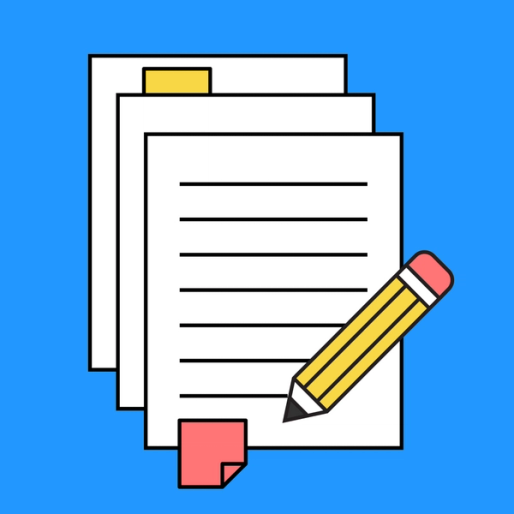
Essay plan template
Share ideas, hone arguments, and refine your writing with our collaborative essay plan template.

Nail down your message
Organize evidence, strengthen supporting arguments, and hammer your main point home with our essay planning sheet.
Create flow: Maintain a cohesive writing process with an essay planning template that clarifies how one section leads to the next.
Evaluate your argument from all sides: Crystallize your claim and test it out from new angles in a visual format.
Do your research: Fact check your work and sources before writing by laying out supporting evidence on an easy-to-read outline.
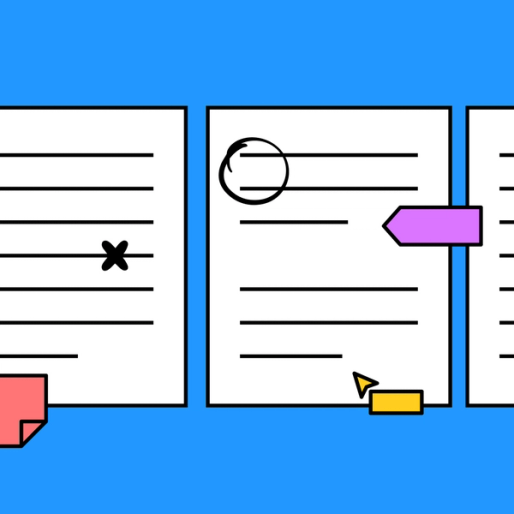
FigJam Make a statement together
Writing doesn’t have to be a solo act. FigJam’s Community-built widgets make it easy to draft with collaborators and source feedback from trusted peers. Fold in new ideas and fine-tune existing arguments with Badge, Storymapper, and Lil notes.
Break it down, then build it up
Perfect the nuts and bolts of your essay with a well-organized essay plan example. Next, find new ways to tell your story with templates from our Community.

Story mapping
Design a compelling narrative step by step.
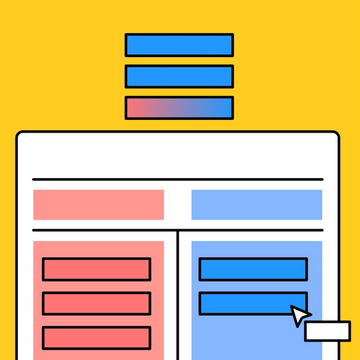
Compare and contrast the main points in your essay.

Other templates from the community
Share your message with peers, mentors, and more with interactive templates.
How to write an essay plan?
If you’re wondering how to plan an essay or how to write an effective essay plan with important points and supporting details, just tap into our free essay plan example to get started. From there, you’ll be prompted to break your essay down into the following sections:
- Introduction
- Body paragraph #1
- Body paragraph #2
- Body paragraph #3
Fill in each of these sections with relevant information and credible sources. Then, share it with your trusted collaborators and peers to make sure your argument sings.
What are the 5 aspects of planning an essay?
The 5 aspects of planning an essay correspond to the 5 main sections of your essay: the introduction, the 3 body paragraphs, and the conclusion.
- Introduction – Planning an introduction involves writing a thesis statement and a brief list that outlines the order of your supporting arguments.
- Body paragraphs (3) – As you plan your 3 body paragraphs, you’ll collect evidence—from credible sources—that backs up any supporting detail, arguments, and thesis.
- Conclusion – While you conceptualize this final section, consider how you can open up the floor for further conversation after the essay ends. Are there any related questions you wished you’d asked? What makes this a relevant topic—today? Jot down all of your ideas on a planning sheet for essays.
What is a good structure in an essay?
Many essays follow the classic 5-part structure—the introduction that states your main argument, the 3 points supporting that claim, and the conclusion that wraps everything up.
Keep in mind, however, that you don't have to follow this essay planning example exactly. Some of the best essays break the mold—so don’t be afraid to customize your essay planning sheet or collaborate on a creative structure as you outline.
Other templates you might like

Explore 1,000+ templates on the Figma community
Explore even more templates, widgets, and plugins—all built by the Figma community.

- 301 Academic Skills Centre
- Study skills online
Essay structure and planning
Information on how to structure and plan your essay.

What is an essay?
An essay is a focused, academic discussion of a particular question, problem or issue.
Many of you have been writing essays for years, and are probably good at it. That's great, and everything you look at here will build on and develop those skills.
But it's worth asking: are there different things expected of a university essay from those for school, college, or other contexts?
The obvious answer is yes, and it takes time and effort to learn the range of writing skills needed to produce university essays effectively.
There are all sorts of reasons why essays are common forms of assessment. They allow you to explore a problem in-depth, express yourself concisely and precisely, and debate other people's published opinions on a topic.
They're also a good warm-up for traditional forms of academic publication, such as a journal article.
Academic essays usually follow an established organisational structure that helps the writer to express their ideas clearly and the reader to follow the thread of their argument.
An essay's structure is guided by its content and argument so every essay question will pose unique structural challenges.
301 Recommends: Glossary of Instruction Words
Our Essay Structure and Planning workshop will outline how to analyse your essay question, discuss approaches logically structure all your ideas, help you make your introductions and conclusions more effective, and teach how to link your ideas and ensure all essay content flows logically from the introduction. The Putting it into Practise workshop
Have a look at our Glossary of Essay Instruction Words (PDF, 100KB) , or watch this short Study Skills Hacks video on identifying the tasks in a question to help you identify what is required.
Planning stages
Essay writing is a process with many stages, from topic selection, planning and reading around, through to drafting, revising and proofreading.
Breaking the task down and creating a clear plan with milestones and intermediate deadlines will allow you to focus attention more fully on the writing process itself when you put your plan into action either as part of an assignment or an exam.
1. Understand the question
- Is the question open-ended or closed? If it is open-ended you will need to narrow it down. Explain how and why you have decided to limit it in the introduction to your essay, so the reader knows you appreciate the wider issues, but that you can also be selective.
- If it is a closed question, your answer must refer to and stay within the limits of the question (ie specific dates, texts, or countries).
- What can you infer from the title about the structure of the essay?
2. Brainstorm for ideas
- What you know about the topic – from lectures, reading etc
- What you don't know about the topic, but need to find out to answer the question
- Possible responses or answers to the question – any ideas about your conclusion.
- Consider using a mind map to organise your thoughts…
3. Make a plan
- Planning your essay makes it more likely that you have a coherent argument
- It enables you to work out a logical structure and an endpoint for your argument before you start writing
- It means you don't have to do this type of complex thinking at the same time as trying to find the right words to express your ideas
- It helps you to commit yourself to sticking to the point!
The Hourglass essay
If you're stuck on an overall structure for your essay, try this simple model for organising a typical academic essay. An hourglass essay introduces a broad area, before narrowing the focus towards the specific question that you are answering. It finishes by placing that narrow area back into a wider context.
Introduction: the funnel of the hourglass
Set the scene and lead your reader into your essay by introducing the broad area of interest and then narrowing towards your specific focus:
- Start broad with a hook to catch the reader's attention
- Provide some context for the hook. What does your project add to it?
- Focus on the narrow area of your essay: can you summarise it in a single sentence mission statement?
Body: the stem of the hourglass
The body of your essay should be as narrow and focused as possible. Body paragraphs will take one sub-topic at a time and provide a logical flow of ideas for your reader:
- Start each paragraph with a topic sentence to tell your reader what it will cover
- Fill your paragraph with a range of supporting evidence and examples
- Finish your paragraph with a final wrapping-up sentence to summarise and/or link ahead
Conclusion: the base of the hourglass
Your chance to reinforce your key messages and go out with a bang:
- Revisit your mission statement: how have you addressed it?
- Summarise the main points of your argument or findings
- Finish with a broader scope, explaining how your topic might inform future research or practice, or where gaps remain
301 Recommends: Essay Planning Template
Use this template (google doc) to plan a structure for your essay, paying particular attention to the ways in which you have broken down the topic into sub-themes for your body paragraphs.
Top tips and resources
- Start planning early, leave your plan for a couple of days, and then come back to it. This may give you a fresh perspective.
- It is often easiest to write the introduction last, but when you are planning your essay structure make sure you have your mission statement.
- A good plan will make it much easier to write a good essay. Invest the time in making a plan that works.
- Check what your tutor wants, but it is often best to focus on one element in great detail, rather than discuss several aspects superficially.
- Make sure you allow time to proofread your work before submission!
Internal resources
- Library Research and Critical Thinking - Referencing
- English Language Teaching Centre (ELTC)– Language Resources
External resources
- Royal Literary Fund– Writing Essays
- University of Reading– Planning and structuring your essay
- Cottrell, S (2008) The Study Skills Handbook. Hampshire: Palgrave Macmillan
- Bailey, S (2003) Academic Writing: A Practical Guide for Students. Routledge
- Reading University– Study Resources
- University of Manchester– Academic Phrasebank
Related information
Academic Skills Certificate
Scientific writing and lab reports
Proofreading

Be the first to hear about our new and upcoming workshops!
The 301 Academic Skills Centre newsletter is a fortnightly email for study skills, mathematics and statistics.
Be the first to find out about our:
- new and upcoming workshops,
- special events and programmes, and
- new and relevant online materials and resources.
Sheffield is a research university with a global reputation for excellence. We're a member of the Russell Group: one of the 24 leading UK universities for research and teaching.
- Jump to menu
- Student Home
- Accept your offer
- How to enrol
- Student ID card
- Set up your IT
- Orientation Week
- Fees & payment
- Academic calendar
- Special consideration
- Transcripts
- The Nucleus: Student Hub
- Referencing
- Essay writing
- Learning abroad & exchange
- Professional development & UNSW Advantage
- Employability
- Financial assistance
- International students
- Equitable learning
- Postgraduate research
- Health Service
- Events & activities
- Emergencies
- Volunteering
- Clubs and societies
- Accommodation
- Health services
- Sport and gym
- Arc student organisation
- Security on campus
- Maps of campus
- Careers portal
- Change password
Construct an Essay Plan
Construct an initial essay plan.
After you have generated some ideas, it’s important to write an initial plan before you head for the library. This can feel strange—after all, how can you answer a question when you haven’t done any research?—but starting with an initial plan helps you order your ideas and focus your reading. Without a sense of which direction to head in, it’s easy to get lost in the research process.
This initial plan will be provisional and might consist of:
- a provisional answer to the question (or thesis statement)
- a brief outline of possible main point.
As you research and develop your understanding of the topic, your ideas will likely change, and your answers may change with them. Try to see your essay plan as something that evolves as you engage further with your topic.
While it’s a good idea to write an initial plan before you start researching, if you really know nothing at all about the topic, some initial skimming and browsing through recommended or assigned readings can provide a few ideas. However, the initial planning stage is not the time for a lot of intensive or detailed reading.
What elements should an essay plan consist of?
A 1-2 sentence thesis statement.
A plan should indicate the answer to the question. A clear and well-written thesis statement will help you to determine the direction and structure of your argument.
What is a thesis statement?
- A clear and direct answer to the essay questio.
- A claim that can be discussed and expanded further in the body of the essay.
- One or two complete sentences.
- A part of the introduction.
In the initial plan, the thesis statement is usually provisional. However, after you’ve done some research, you will need to work on your thesis statement until it is clear, concise and effective.
- Try introducing your thesis statement with the phrase ‘this essay will argue’ or ‘this essay argues’.
- Paraphrasing the assignment question can help ensure that you are answering it.
Possible main points
Once you have a thesis statement, follow it with a paragraph or a set of points that indicate the ‘reasons why’ for your answer. The ‘reasons why’ can be developed into the main points of your essay.
What are main points?
- Main points make up the body of an essay.
- Each point should be developed in a paragraph. These paragraphs are the building blocks used to construct the argument.
- In a 1000-1500 word essay, aim for three to four main points
In the initial plan, try to express the main idea of each point in a single, clear sentence. These can become topic sentences—usually the first sentence of each paragraph which summarise the information in the paragraph. In your second plan, you develop these points further.
Arrange your main points in a logical order and number them. Is there one that would seem to go first or one that would seem to go last? Are there any two that are closely linked? How are the ideas connected to each other? Do the main points, when considered as a whole, present a unified discussion?).
The structure of the essay
A plan should follow the structureof an essay, e.g. Introduction, body and conclusion.
While you may not be ready to construct an introduction or conclusion, this three-part structure should be at least suggested in your plan.
Some indication of the research
A plan should include some indication of the sources you might use to RESEARCH the topic.
Make a few notes about how each main point might be developed. If possible, specify the evidence you might draw on and which texts you might refer to. Jot down titles, authors, page numbers etc.
Next: Step 4 - Research and gather information
Essay and assignment writing guide.
- Essay writing basics
- Analyse the task
- Work out your ideas
- Construct an essay plan
- Research and gather information
- Write a second essay plan
- Answering assignment questions
- Editing checklist
- Writing a critical review
- Annotated bibliography
- Reflective writing
- ^ More support
Study Hacks Workshops | All the hacks you need! 7 Feb – 10 Apr 2024
Essay Writing Guide
Essay Outline
Last updated on: Jun 10, 2023
A Complete Essay Outline - Guidelines and Format
By: Nova A.
13 min read
Reviewed By: Melisa C.
Published on: Jan 15, 2019

To write an effective essay, you need to create a clear and well-organized essay outline. An essay outline will shape the essay’s entire content and determine how successful the essay will be.
In this blog post, we'll be going over the basics of essay outlines and provide a template for you to follow. We will also include a few examples so that you can get an idea about how these outlines look when they are put into practice.
Essay writing is not easy, but it becomes much easier with time, practice, and a detailed essay writing guide. Once you have developed your outline, everything else will come together more smoothly.
The key to success in any area is preparation - take the time now to develop a solid outline and then write your essays!
So, let’s get started!

On this Page
What is an Essay Outline?
An essay outline is your essay plan and a roadmap to essay writing. It is the structure of an essay you are about to write. It includes all the main points you have to discuss in each section along with the thesis statement.
Like every house has a map before it is constructed, the same is the importance of an essay outline. You can write an essay without crafting an outline, but you may miss essential information, and it is more time-consuming.
Once the outline is created, there is no chance of missing any important information. Also, it will help you to:
- Organize your thoughts and ideas.
- Understand the information flow.
- Never miss any crucial information or reference.
- Finish your work faster.
These are the reasons if someone asks you why an essay outline is needed. Now there are some points that must be kept in mind before proceeding to craft an essay outline.

Easily Outline Your Essays In Seconds!
Prewriting Process of Essay Outline
Your teacher may ask you to submit your essay outline before your essay. Therefore, you must know the preliminary guidelines that are necessary before writing an essay outline.
Here are the guidelines:
- You must go through your assignments’ guidelines carefully.
- Understand the purpose of your assignment.
- Know your audience.
- Mark the important point while researching your topic data.
- Select the structure of your essay outline; whether you are going to use a decimal point bullet or a simple one.

Paper Due? Why Suffer? That's our Job!
How to Write an Essay Outline in 4 Steps
Creating an essay outline is a crucial step in crafting a well-structured and organized piece of writing. Follow these four simple steps to create an effective outline:
Step 1: Understand the Topic
To begin, thoroughly grasp the essence of your essay topic.
Break it down into its key components and identify the main ideas you want to convey. This step ensures you have a clear direction and focus for your essay.
Step 2: Brainstorm and Gather Ideas
Let your creativity flow and brainstorm ideas related to your topic.
Jot down key pieces of information, arguments, and supporting evidence that will strengthen your essay's overall message. Consider different perspectives and potential counterarguments to make your essay well-rounded.
Step 3: Organize Your Thoughts
Now it's time to give structure to your ideas.
Arrange your main points in a logical order, starting with an attention-grabbing introduction, followed by body paragraphs that present your arguments.
Finally, tie everything together with a compelling conclusion. Remember to use transitional phrases to create smooth transitions between sections.
Step 4: Add Depth with Subpoints
To add depth and clarity to your essay, incorporate subpoints under each main point.
These subpoints provide more specific details, evidence, or examples that support your main ideas. They help to further strengthen your arguments and make your essay more convincing.
By following these four steps - you'll be well on your way to creating a clear and compelling essay outline.
Essay Outline Format
It is an easy way for you to write your thoughts in an organized manner. It may seem unnecessary and unimportant, but it is not.
It is one of the most crucial steps for essay writing as it shapes your entire essay and aids the writing process.
An essay outline consists of three main parts:
1. Introduction
The introduction body of your essay should be attention-grabbing. It should be written in such a manner that it attracts the reader’s interest. It should also provide background information about the topic for the readers.
You can use a dramatic tone to grab readers’ attention, but it should connect the audience to your thesis statement.
Here are some points without which your introduction paragraph is incomplete.
To attract the reader with the first few opening lines, we use a hook statement. It helps engage the reader and motivates them to read further. There are different types of hook sentences ranging from quotes, rhetorical questions to anecdotes and statistics, and much more.
Are you struggling to come up with an interesting hook? View these hook examples to get inspired!
A thesis statement is stated at the end of your introduction. It is the most important statement of your entire essay. It summarizes the purpose of the essay in one sentence.
The thesis statement tells the readers about the main theme of the essay, and it must be strong and clear. It holds the entire crux of your essay.
Need help creating a strong thesis statement? Check out this guide on thesis statements and learn to write a statement that perfectly captures your main argument!
2. Body Paragraphs
The body paragraphs of an essay are where all the details and evidence come into play. This is where you dive deep into the argument, providing explanations and supporting your ideas with solid evidence.
If you're writing a persuasive essay, these paragraphs will be the powerhouse that convinces your readers. Similarly, in an argumentative essay, your body paragraphs will work their magic to sway your audience to your side.
Each paragraph should have a topic sentence and no more than one idea. A topic sentence is the crux of the contents of your paragraph. It is essential to keep your reader interested in the essay.
The topic sentence is followed by the supporting points and opinions, which are then justified with strong evidence.
3. Conclusion
When it comes to wrapping up your essay, never underestimate the power of a strong conclusion. Just like the introduction and body paragraphs, the conclusion plays a vital role in providing a sense of closure to your topic.
To craft an impactful conclusion, it's crucial to summarize the key points discussed in the introduction and body paragraphs. You want to remind your readers of the important information you shared earlier. But keep it concise and to the point. Short, powerful sentences will leave a lasting impression.
Remember, your conclusion shouldn't drag on. Instead, restate your thesis statement and the supporting points you mentioned earlier. And here's a pro tip: go the extra mile and suggest a course of action. It leaves your readers with something to ponder or reflect on.
5 Paragraph Essay Outline Structure
An outline is an essential part of the writing as it helps the writer stay focused. A typical 5 paragraph essay outline example is shown here. This includes:
- State the topic
- Thesis statement
- Introduction
- Explanation
- A conclusion that ties to the thesis
- Summary of the essay
- Restate the thesis statement
Tough Essay Due? Hire Tough Writers!
Essay Outline Template
The outline of the essay is the skeleton that you will fill out with the content. Both outline and relevant content are important for a good essay. The content you will add to flesh out the outline should be credible, relevant, and interesting.
The outline structure for the essay is not complex or difficult. No matter which type of essay you write, you either use an alphanumeric structure or a decimal structure for the outline.
Below is an outline sample that you can easily follow for your essay.
Essay Outline Sample
Essay Outline Examples
An essay outline template should follow when you start writing the essay. Every writer should learn how to write an outline for every type of essay and research paper.
Essay outline 4th grade
Essay outline 5th grade
Essay outline high school
Essay outline college
Given below are essay outline examples for different types of essay writing.
Argumentative Essay Outline
An argumentative essay is a type of essay that shows both sides of the topic that you are exploring. The argument that presents the basis of the essay should be created by providing evidence and supporting details.
Persuasive Essay Outline
A persuasive essay is similar to an argumentative essay. Your job is to provide facts and details to create the argument. In a persuasive essay, you convince your readers of your point of view.
Compare and Contrast Essay Outline
A compare and contrast essay explains the similarities and differences between two things. While comparing, you should focus on the differences between two seemingly similar objects. While contrasting, you should focus on the similarities between two different objects.
Narrative Essay Outline
A narrative essay is written to share a story. Normally, a narrative essay is written from a personal point of view in an essay. The basic purpose of the narrative essay is to describe something creatively.
Expository Essay Outline
An expository essay is a type of essay that explains, analyzes, and illustrates something for the readers. An expository essay should be unbiased and entirely based on facts. Be sure to use academic resources for your research and cite your sources.
Analytical Essay Outline
An analytical essay is written to analyze the topic from a critical point of view. An analytical essay breaks down the content into different parts and explains the topic bit by bit.
Rhetorical Analysis Essay Outline
A rhetorical essay is written to examine the writer or artist’s work and develop a great essay. It also includes the discussion.
Cause and Effect Essay Outline
A cause and effect essay describes why something happens and examines the consequences of an occurrence or phenomenon. It is also a type of expository essay.
Informative Essay Outline
An informative essay is written to inform the audience about different objects, concepts, people, issues, etc.
The main purpose is to respond to the question with a detailed explanation and inform the target audience about the topic.
Synthesis Essay Outline
A synthesis essay requires the writer to describe a certain unique viewpoint about the issue or topic. Create a claim about the topic and use different sources and information to prove it.
Literary Analysis Essay Outline
A literary analysis essay is written to analyze and examine a novel, book, play, or any other piece of literature. The writer analyzes the different devices such as the ideas, characters, plot, theme, tone, etc., to deliver his message.
Definition Essay Outline
A definition essay requires students to pick a particular concept, term, or idea and define it in their own words and according to their understanding.
Descriptive Essay Outline
A descriptive essay is a type of essay written to describe a person, place, object, or event. The writer must describe the topic so that the reader can visualize it using their five senses.
Evaluation Essay Outline
Problem Solution Essay Outline
In a problem-solution essay, you are given a problem as a topic and you have to suggest multiple solutions on it.
Scholarship Essay Outline
A scholarship essay is required at the time of admission when you are applying for a scholarship. Scholarship essays must be written in a way that should stand alone to help you get a scholarship.
Reflective Essay Outline
A reflective essay is written to express your own thoughts and point of view regarding a specific topic.
Getting started on your essay? Give this comprehensive essay writing guide a read to make sure you write an effective essay!
With this complete guide, now you understand how to create an outline for your essay successfully. However, if you still can’t write an effective essay, then the best option is to consult a professional academic writing service.
Essay writing is a dull and boring task for some people. So why not get some help instead of wasting your time and effort? 5StarEssays.com is here to help you. All your do my essay for me requests are managed by professional essay writers.
Place your order now, and our team of expert academic writers will help you.
Frequently Asked Questions
What are the three types of outlines.
Here are the three types of essay outline;
- Working outline
- Speaking outline
- Full-sentence outline
All three types are different from each other and are used for different purposes.
What does a full-sentence outline look like?
A full sentence outline contains full sentences at each level of the essay’s outline. It is similar to an alphanumeric outline and it is a commonly used essay outline.
What is a traditional outline format?
A traditional essay outline begins with writing down all the important points in one place and listing them down and adding sub-topics to them. Besides, it will also include evidence and proof that you will use to back your arguments.
What is the benefit of using a traditional outline format and an informal outline format?
A traditional outline format helps the students in listing down all the important details in one palace while an informal outline will help you coming up with new ideas and highlighting important points

As a Digital Content Strategist, Nova Allison has eight years of experience in writing both technical and scientific content. With a focus on developing online content plans that engage audiences, Nova strives to write pieces that are not only informative but captivating as well.
Was This Blog Helpful?
Keep reading.
- How to Write an Essay - A Complete Guide with Examples

- The Art of Effective Writing: Thesis Statements Examples and Tips

- Writing a 500 Word Essay - Easy Guide

- What is a Topic Sentence - An Easy Guide with Writing Steps & Examples

- 220 Best Transition Words for Essays

- Essay Format: Detailed Writing Tips & Examples

- How to Write a Conclusion - Examples & Tips

- Essay Topics: 100+ Best Essay Topics for your Guidance

- How to Title an Essay: A Step-by-Step Guide for Effective Titles

- How to Write a Perfect 1000 Word Essay

- How To Make An Essay Longer - Easy Guide For Beginners

- Learn How to Start an Essay Effectively with Easy Guidelines

- Types of Sentences With Examples

- Hook Examples: How to Start Your Essay Effectively

- Essay Writing Tips - Essential Do’s and Don’ts to Craft Better Essays

- How To Write A Thesis Statement - A Step by Step Guide

- Art Topics - 200+ Brilliant Ideas to Begin With

- Writing Conventions and Tips for College Students

People Also Read
- book review examples
- opinion essay
- writing an analytical essay
- autobiography format
- persuasive essay examples
Burdened With Assignments?

Advertisement
- Homework Services: Essay Topics Generator
© 2024 - All rights reserved
Find Study Materials for
- Business Studies
- Combined Science
- Computer Science
- Engineering
- English Literature
- Environmental Science
- Human Geography
- Macroeconomics
- Microeconomics
- Social Studies
- Browse all subjects
- Read our Magazine
Create Study Materials
A good essay doesn't appear out of thin air — it develops from a plan. Essay planning is essential to ensure your essay is organized and coherent. Using a plan to begin your essay writing process will help you figure out your main idea , topic sentences, and details. Luckily, tried and tested essay planning sheets and templates can assist you with outlining your essay and improving your writing skills.

Explore our app and discover over 50 million learning materials for free.
Want to get better grades?
Get free, full access to:.
- Explanations
- Study Planner
- Textbook solutions
- StudySmarter AI
- Textbook Solutions
- 5 Paragraph Essay
- Argumentative Essay
- Cues and Conventions
- English Grammar
- English Language Study
- Essay Time Management
- How To Take a Position in an Essay
- Organize Your Prompt
- Proofread Essay
- Understanding the Prompt
- Essay Prompts
- Essay Writing Skills
- Global English
- History of English Language
- International English
- Key Concepts in Language and Linguistics
- Language Acquisition
- Language Analysis
- Language and Social Groups
- Lexis and Semantics
- Linguistic Terms
- Listening and Speaking
- Multiple Choice Questions
- Research and Composition
- Rhetorical Analysis Essay
- Single Paragraph Essay
- Sociolinguistics
- Summary Text
- Synthesis Essay
- Textual Analysis
Lerne mit deinen Freunden und bleibe auf dem richtigen Kurs mit deinen persönlichen Lernstatistiken
Nie wieder prokastinieren mit unseren Lernerinnerungen.
A good essay doesn't appear out of thin air — it develops from a plan. Essay planning is essential to ensure your essay is organized and coherent. Using a plan to begin your essay writing process will help you figure out your main idea , topic sentences, and details. Luckily, tried and tested essay planning sheets and templates can assist you with outlining your essay and improving your writing skills.
How to Begin Planning Your Essay
You need to take a few steps to begin planning your essay.
Decide on an Essay Topic
If your teacher didn't provide an essay topic, consider some questions, events, or ideas that you feel are important and would like to expand on. If they did provide an essay topic, identify keywords and phrases to focus on. You should strive to use these keywords throughout your essay and as a basis for your research plan.
Essay Plan: Research Your Thesis and Take Notes
Your teacher may have already provided you with some reference material or links to reputable sources. If so, plan on using this material to kickstart your research on the topic. Supplement this with your own findings as needed. If you're starting from scratch, use reputable sources to research your topic, and keep a list of references as you do this if you are required to cite your information. Some credible sources include dictionaries, encyclopedias, textbooks, and many websites with .edu or .org domains.
Essay Plan: Organize Your Research and Ideas
You can use a mind map, essay plan sheet, or other essay planning tools to organize your research and main ideas. See the essay plan sheet in the "Structuring your Essay" section for an example. Organizing your research and ideas will help you plan out your main topic sentences for each paragraph and the order of these paragraphs. You'll also use this step to structure your research into supporting sentences for each main topic. Write a concluding sentence at the end of each paragraph to summarize how they contribute to the main topic.
Essay Plan: Write Your First Draft
Once you've organized your ideas using an essay planning tool of your choice, you're ready to write your first draft. Use your essay plan sheet to form your introduction, the topic sentence for each paragraph, supporting details, concluding sentences, and your overall conclusion. Remember, your first draft doesn't have to be perfect.
Essay Plan: Edit and Revise
Once you complete your first draft, it's time to re-read, edit, and revise your essay. Use this time to cut out unnecessary details and restructure your essay. Here are some helpful tips to improve your editing skills:
- Print out your essay and read it out loud slowly. Listen for ways to improve the clarity and overall flow of your essay.
- Check for spelling, punctuation, and grammar errors.
- Ask a friend or schoolmate to read your essay and give you suggestions and corrections.
Structuring Your Essay
Because structuring your essay can seem daunting, the best way to help you is to use an essay planning sheet.
Essay Planning Sheet
An essay planning sheet (sometimes called a template) is a document that gives you some suggested categories to organize your essay topic and main points. These plans will help to improve your essay formatting skills. Planning sheets have different formats and offer different suggestions, but most include the following:
- Thesis /Essay Topic
- Introduction
- Topic Sentence
- Supporting Details
- Concluding Sentence
You can find free essay plan sheets online or create your own. You can also use a mind map or box plan to organize your writing. Here is an example of an essay planning sheet for a general five-paragraph essay:

Essay Plan: Introduction
In the introduction, you'll want to ensure you present your argument , idea, or thesis in this section. Do your best to start with an attention-grabbing hook or introductory statemen t that will keep your reader interested in your essay. Thought-provoking questions, interesting quotes, or controversial statements can be good tools to use in your introduction. After you have drawn your reader in, it is important to state your thesis statement (a sentence or two summarizing the main argument of your essay). Your order of topics comes last and gives your reader an overview of the main supporting points you will make in your essay. This will help your reader to follow your argument from the get-go. Improving the quality of your introduction is a skill that comes with time and is a crucial part of the writing process.
Essay Plan: Paragraph Structure
Each paragraph should start with a topic sentence that presents a main idea or argument that supports your main point. You should include at least three supporting details in each paragraph. These details should provide quotes from reputable sources, data, verifiable facts, or other information that gives weight to your topic sentence. Finish with a concluding sentence to summarize the overall argument in each paragraph.
Essay Plan: Conclusion
Writing an effective conclusion is an important skill to help your reader remember the main idea or argument of your writing. You should restate your thesis, main points, and key findings from your supporting paragraphs . Finish off your essay with your concluding statement . Similar to the concluding sentences you have created in your previous paragraphs, the concluding statement wraps up your essay and signals to the reader that you have completed your argument. Don't include any new information in your conclusion. This paragraph is intended to summarize and restate what your reader has already learned in your essay.
Remember, readers often remember the first and last few sentences of an essay more easily than the overall text. Use quotes, questions, or statements that will grab the attention of your readers and leave a lasting impression on them.
Essay Plan Example
Let's create an example essay plan using the planning sheet we previously discussed. First, if you don't already have an essay topic or thesis, take the time to choose one. For this example, we'll use the topic "intercultural awareness."
Your first step in the writing process would be to research intercultural awareness. There are many aspects to this topic, so it might be helpful to think of a question regarding intercultural awareness that you'd like to answer. A mind map can help organize your thoughts and discover what you already know about this topic. After completing your research and mind map, use this information to figure out your main topic sentences. Take the time to arrange these main topics in a logical order and ensure these topics relate to your thesis.

Now that we have our main topic sentences, we can use our research to add supporting details and form our paragraphs. Be sure to add references to the end of your essay if these details include quotes, data, paraphrased text, or facts. Once you've completed the body of your essay, you can flesh out your introduction and conclusion. Be sure to use attention-grabbing sentences and paraphrase your main idea and topic sentences in these introductory and concluding paragraphs.
Here is an example of a completed essay planning sheet:
Essay Topic: Why is intercultural awareness important for business?
Don't forget to add your references to your essay and cite them in the required format.
Essay Planning Next Steps
Once you've filled out your essay planning sheet, it's time to write your first draft! Using an essay planning sheet or template and looking at other essay examples can help you to organize your writing logically and coherently. These tools will help ensure you've included all the necessary parts for a successful essay in your writing process.
Essay Plan - Key takeaways
Decide on your thesis if your teacher hasn't provided one.
Use credible sources to research your thesis.
Use a mind map, essay planning sheet, or other essay planning tools to organize your ideas.
Write out your first draft.
Re-read, edit, and revise your essay.
1 Stephen Covey, The 7 Habits of Highly Effective People (1989).
Frequently Asked Questions about Essay Plan
--> how to plan an essay, --> how do i structure an essay plan.
Make sure your essay plan structure includes space to note down your:
- introduction
- topic sentences
- supporting details
- concluding sentences
--> When planning a narrative essay what should the writer do?
Look for an essay planning sheet or template designed specifically for a narrative essay. This type of planning sheet can help you make sure you've included the necessary details and used the right structure in your essay.
--> How do I plan an essay outline?
First, decide on your thesis or main topic if you haven't been provided one. Next, use that as the basis for your research. Use an essay outline tool or make your own to organize your thoughts into the key parts of your essay.
--> How to plan an expository essay?
Look for an essay plan sheet designed specifically for an expository essay. This type of planning sheet can help you make sure you've included the necessary details and used the right structure in your essay.
Test your knowledge with multiple choice flashcards
Which sentence had been proofread and corrected?
Which sentence correctly used a modifier?
Which sentence is complete?
Your score:


Join the StudySmarter App and learn efficiently with millions of flashcards and more!
Learn with 147 essay plan flashcards in the free studysmarter app.
Already have an account? Log in
What areas should you check while proofreading your essay?
Grammar, spelling, and typography.
What grammar points should you look for while proofreading?
Make sure your verb tense is correct, subject and verbs are in agreement and you've used the correct pronouns.
What tips can improve your proofreading?
Print your essay, read it out loud slowly and have a friend check it for errors.
What common spelling errors should you look for?
Check if you've properly used its vs. it's or you're vs. your. Also be careful about using their, there or they're.
How can you check your spelling?
Use online proofreading services or editing tools to check your spelling. Read your writing out loud. Have a friend read your essay and look for errors.
How can you make sure your verb tense is correct?
Print out a copy of your essay. Circle the verbs in each sentence. Make sure they are all in the same tense.

- English Grammar Summary
of the users don't pass the Essay Plan quiz! Will you pass the quiz?
How would you like to learn this content?
Free english cheat sheet!
Everything you need to know on . A perfect summary so you can easily remember everything.
Join over 22 million students in learning with our StudySmarter App
The first learning app that truly has everything you need to ace your exams in one place
- Flashcards & Quizzes
- AI Study Assistant
- Smart Note-Taking

Sign up to highlight and take notes. It’s 100% free.
This is still free to read, it's not a paywall.
You need to register to keep reading, create a free account to save this explanation..
Save explanations to your personalised space and access them anytime, anywhere!
By signing up, you agree to the Terms and Conditions and the Privacy Policy of StudySmarter.
Entdecke Lernmaterial in der StudySmarter-App

Privacy Overview

When you are able to develop a skill in essay writing , you will realize how it is able to take your time and a lot of patience to improve more. Writing an essay would help you talk about a particular worldly issue without showing any biases. Essays are more on facts and a little of your opinion. Essays give writers the chance to incorporate their own experiences, the way how they think and their ability provide research data. It is an essential part in the learning process that enables you to mark your point of view. In this article, you will be able to encounter more about the idea of creating a simple yet presentable essay plan .
10+ Essay Plan Examples
1. essay plan template.
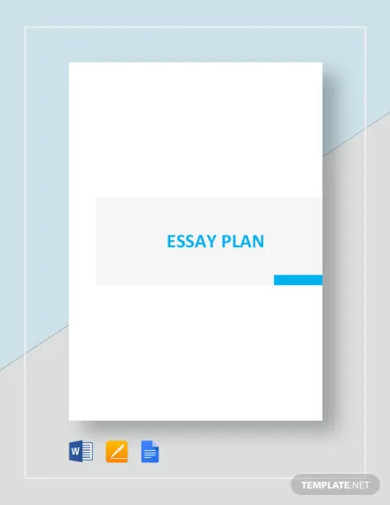
- Google Docs
2. Essay Plan Mind Map Template
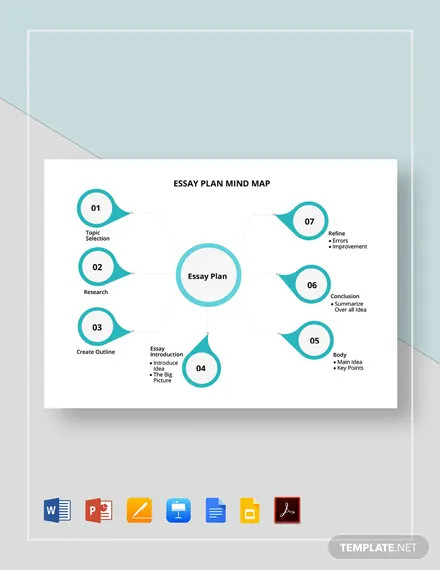
- Google Slides
3. New Essay Plan Template
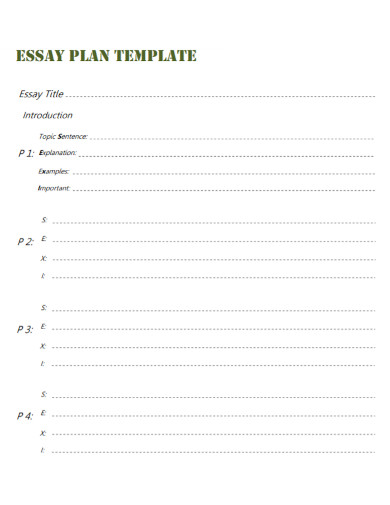
Size: 208 KB
4. Good Essay Plan
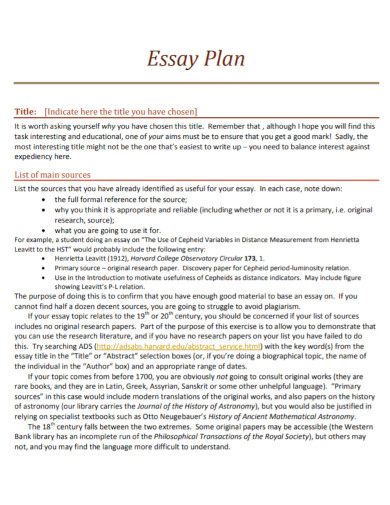
Size: 114 KB
5. Assignment Essay Plan
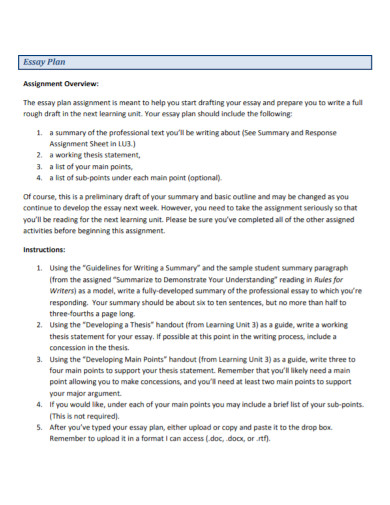
Size: 596 KB
6. Accessible Essay Plan
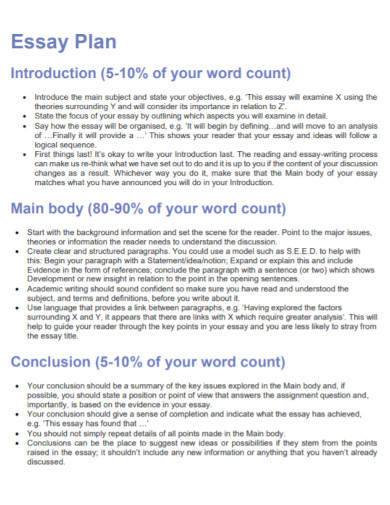
Size: 57 KB
7. Outlining of Essay Plan
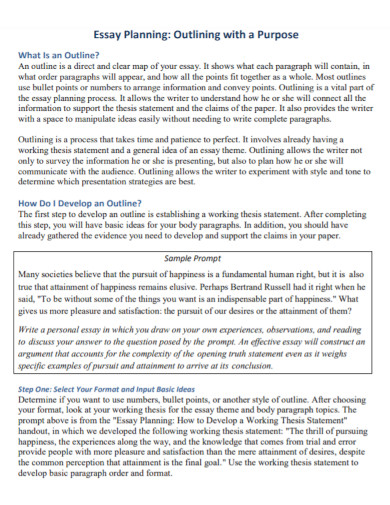
Size: 457 KB
8. Argumentative Essay Plan
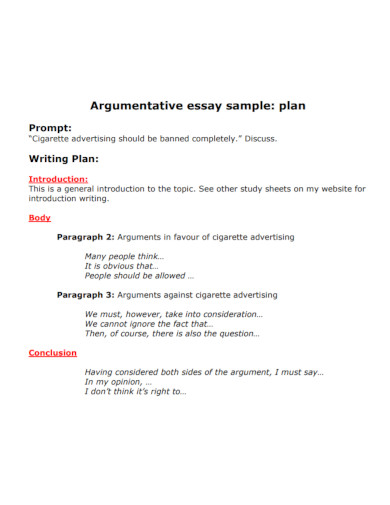
Size: 97 KB
9. Semantic Structure Essay Plan
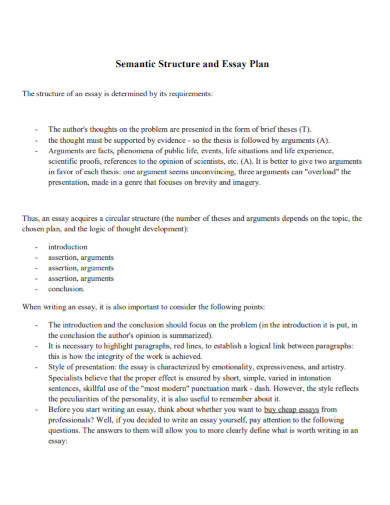
10. Basic Essay Plan
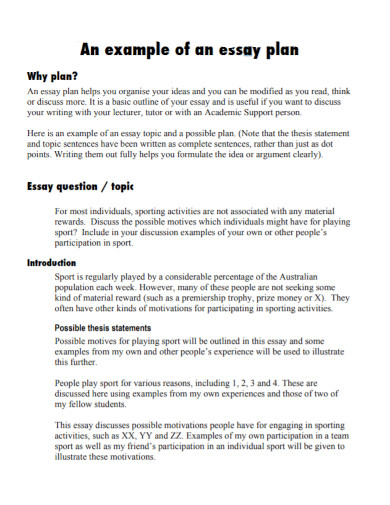
Size: 427 KB
11. Essay Plan Checklist
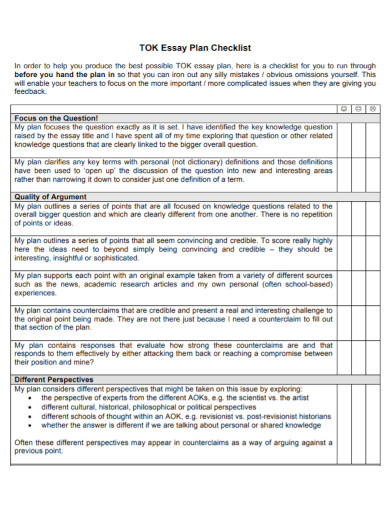
Size: 58 KB
What is an Essay Plan?
An essay plan is an act of making you practice how to organize ideas and make further modifications. It serves as an outline that is essential to use for discussing or writing about a certain issue. The purpose of an essay is to practice your mind on how to focus on an area where it can bring you to make a quality conclusion .
Planning is the way how you are able to visualize regarding the content of your essay. You should make sure that your essay is well-planned. Otherwise, you will end up having a sequence of phrases that are not even organized. Your main points should be clear and logically stated.
10 Steps for Essay Planning
- Read and analyze the essay questions.
- Write down the essay questions.
- Brainstorm or think of more ideas regarding the matter.
- List down all of your thoughts and the scope that covers the essay questions.
- Take note of the words or phrases that you think are essential in your work.
- Write down the main points that can be used to answer the questions.
- Look through any type of handouts that can be used to have a more detailed outline of your essay.
- Do not forget to take note of the sources of all the information you got. This will be indicated in the reference list.
- Do not make your outline too complicated.
- Think about how many words you need to write, the elements that you cover in your essay and how much space you should be able to allot to each of your outline section.
Here is an outline of your essay that you need to follow:
- Essay question or topic
- Introduction – this includes your thesis statement
- 1 st Paragraph – this includes your topic sentence and evidence
- 2 nd Paragraph – this also contains a topic sentence and evidence
- 3 rd Paragraph – just like the first and second paragraph, it contains a topic sentence or an idea that is supported by an evidence or claim
- Conclusion – provides the possible motivations and restatement of central idea
- Reference – the list of the sources of your texts, data or images that you do not own
What is a good essay?
A good essay must have one clear main idea. Each of the paragraphs must have a topic sentence to be supported with a supporting detail. They should be organized logically and must be able to stick together. Always make sure that an essay would give a best impression to the readers.
What is the standard number of paragraphs per essay?
Essays must have at least five paragraphs.
What is the best way to start an essay plan?
The best way to start an essay plan is to prepare a box plan that consists of the essay elements. These elements will serve as your guide to be able to write continuously without getting lost of the usual standard arrangement.
Effective essay planning helps in making your work be done immediately. It speeds up your writing process and gives you precise direction while working on it. You just have to follow the correct structure and format of your essay. Always consider your audience when making an essay because they are the ones who will give you feedback about it. The attention that they should give also matters.

Essay Plan Generator
Text prompt
- Instructive
- Professional
Create an Essay Plan on how you organize your study schedule and its benefits
Develop an Essay Plan on the role of exercise in student life
How to Write an Essay Plan
Essay planning might seem like a waste of time, but it’s not! In fact, planning your essays will save you time and energy in the long-run.
This is because it’s much easier to write an essay that’s already been planned. You won’t need to worry about which point should come next or whether your argument is strong enough. Instead, you can focus purely on writing the essay.
So, if you want to ease the stress of essay writing and improve your grades, make essay planning a priority!
How will planning improve my grades?
Essays plans can:
- Help you create a clear structure
- Help you distribute the word count evenly
- Prevent you from missing material out
- Help you build a strong argument
- Allow you to get feedback (many tutors will look at essay plans)
- Alleviate writer’s block (when it comes to writing the essay)
Once you’ve written a few essay plans, you’ll appreciate just how much value they can add to your essays.
What does an essay plan look like?
An essay plan is a skeleton outline of your essay. It summarises what will be included in each paragraph and how the paragraphs will link together. It also states how many words will be used in each section, and the key references that’ll be used. Check out the essay plan template below for more details.
Essay plan template
Essay title: [….], introduction – […] words.
- Engage with the essay question: [….]
- State your position or argument: [….]
- State any theories or frameworks that will inform the essay (if applicable): […]
- Outline the structure of the essay: [….]
Paragraph 1 – […] words
- Outline your first key point: [….]
- Provide evidence (empirical research, theories, examples etc): [….]
- Consider any criticisms of the above, then rebut: […]
- Restate the main point and its relevance to the overall argument, link to next paragraph: […]
Paragraph 2 – […] words
- Outline your second key point: [….]
- Consider any criticisms of the above, then rebut […]
Paragraph 3 – […] words
- Outline third key point: [….]
- Restate the main point and its relevance to the overall argument: […]
Conclusion – […] words
- Revisit the essay question and re-state your position/argument: [….]
- Summarise the points from each paragraph: [….]
- Offer a slightly new perspective and leave a lasting impression: [….]
- List the key references to be used: [….]
Total word count: […]
It’s worth mentioning that essay plans aren’t perfect. They provide an outline of the essay, but some elements will probably change during the write-up process. In many ways, writing an essay plan is like planning a car journey. You’ll have a clear sense of where you’re going, but you might have to take some detours along the way.
A step-by-step guide to filling in the essay plan
If the essay plan template looks daunting then don’t worry, try breaking it down into stages:
1. Interpret and rephrase the essay question
You’ll see that the first stage of the essay plan asks you to ‘engage with the essay question’ .
Often, essays fail because they haven’t answered the question. That said, you should begin by making sure you understand the essay question. To do this, take a copy of the essay title and highlight the most important phrases. Then, slightly rephrase the question, and add it to your essay plan.
As an example,
Engage with the essay question: This essay critically evaluates what the gig economy means for employment relations issues, particularly workers’ rights and work-life balance.
2. State your position or argument
As shown above, the next stage of the essay plan is to state your position or argument. You will need to have done some research/background reading to get a sense of what you want to ‘argue’ in your essay. As an example,
3. Choose your key points
Once you’ve planned your introduction, it’s time to choose the themes that will be covered in your paragraphs. You should only include one key point per paragraph. Example:
Paragraph 1 – 150 words
- Outline your first key point: Some gig economy workers are labelled as ‘independent contractors’, rather than ‘workers’ (even though they do the duties of ‘workers’). This means that they are not entitled to employment rights such as sick pay and holiday pay. By labelling their staff as ‘independent contractors’, these companies undermine workers’ rights.
- Provide evidence (empirical research, theories, examples etc): Deliveroo will be used as an example. Employee experiences reported in the press (see Smith, 2018) and journal articles relating to this case will be cited (see Adams, 2019). Also, employment rights legislation will be presented (Gov, 2020).
- Consider any criticisms of the above, then rebut: Independent workers’ unions have helped some gig-economy workers fight back and achieve ‘worker’ status. This suggests that the gig economy is not inevitably exploitative. However, the unions have not been able to achieve ‘worker’ status for Deliveroo riders, despite fighting hard.
- Restate the main point and its relevance to the overall argument, link to next paragraph: As such, this substantiates the suggestion that some gig economy companies have undermined centuries of workers’ rights progress. As such, it can be said that some gig economy companies are leaving workers vulnerable to exploitation. Indeed, another exploitative facet of the gig economy is that workers often carry a high ‘burden of responsibility’ but are not comparatively compensated, as is explored in the next paragraph.
If you want to learn more about how to structure your paragraphs, check out our guidance on how to structure an essay .
4. Gather the evidence
When writing your plan, make a note of the key sources you will use in your essay. You’ll notice that under each paragraph, it says to ‘Provide evidence (empirical research, theories, examples etc)’.
It’s advisable to include at least one reference per paragraph. The more references you can gather before you start writing your essay, the better! Also, put the full citation in the ‘Reference list’ section of your essay plan so that you don’t lose it.
5. Offer a slightly new perspective and leave a lasting impression
Good essay conclusions don’t just repeat material that was discussed in the essay. Rather, they offer a slightly advanced perspective on the material that was discussed in the essay. This ‘advanced’ perspective can be quite difficult to plan for as it is often realised as a result of actually writing the essay.
However, this point has still been included in the essay plan template as it acts as a reminder. Want more tips on how to write an essay conclusion? Check out our detailed guidance!
6. Divide up the word count
You will notice that, next to each paragraph on the essay plan, there’s a space to fill in the suggested word count. Dividing up the word count before you start writing will stop you from exceeding the word limit when you write up your essay.
Essays are all different, but, as a general rule, the word count tends to be allocated as follows:
- Intro – 5-10%
- Main body (split into paragraphs) – 80-90%
- Conclusion – 5-10%
To create a sense of balance, try to keep all the paragraphs a similar length.
When done properly, an essay plan can take several hours to write. But, as mentioned, it’ll save you so much time and energy in the long run. Not to mention, it’ll make the writing process a lot less stressful!
You may also like

How to Write an Essay Plan: An Example

Before you start writing your essay, it is important that you plan it. Below is an example of what an essay plan should look like (including explanations and tips), and how much detail it should contain. You can use this as a guide for your essay plans.
Click Here to Download a Free Essay Template
Essay Question: Has climate change affected Australian ecosystems?
Word Limit: 2,000 words
Introduction (10% of word limit): 200 words
Introductions should never be longer than 500 words, so this 10% guide only applies to essays shorter than 5,000 words.
To be considered an Introduction, an Introduction must do two things:
Answer the question—Climate change has had a profound impact on Australian ecosystems. This must be done first. An Introduction must answer the question. This is how you put forward a strong argument.
List the evidence your essay will put forward to prove your answer—This can be seen through an examination of scientific research, government agency reports and environmental organisation reports and case studies of specific ecosystems in Australia. Any major topic or subject that you plan to discuss in your essay must be introduced in the Introduction.
Body of the Essay: 400 words each
How long you spend writing about each subject should reflect the importance of each subject. If all four topics are of equal importance, write roughly the same amount of words on each. If a topic is more important, write about it first and write more words on it. If a topic is less important, write about it last and write fewer words on it.
Topic 1: scientific research
Topic 2: government agency reports
Topic 3: environmental agency reports
Topic 4: case studies of specific ecosystems in Australia
Conclusion (10% of word limit): 200 words
Conclusions should never be longer than 500 words, so this 10% guide only applies to essays shorter than 5,000 words.
To be considered a Conclusion, a Conclusion must do two things:
Answer the essay question again (using different words than in the Introduction. Don’t repeat yourself exactly)—Australian ecosystems have been significantly affected by climate change.
Recap (repeat, summarise) all the evidence you have given to prove your answer during your essay—scientific research, government agency reports, environmental agency reports, case studies of specific ecosystems.
A conclusion must not contain any new information. You are only summarising what you have already written.

Updated 6 March 2023 Ellen McRae, PhD, AE (IPEd), MNZSTI Senior Managing Editor
2 thoughts on “How to Write an Essay Plan: An Example”
This was so helpful! Thank you.
Comments are closed.
Request a quote
Please enter your details and we will email a quote to you.
- Enter the Word Count of your document *
- Phone This field is for validation purposes and should be left unchanged.
HELP: FORMATTING
- Choose 'leave formatting as it is' if you would like us to maintain the current formatting in your document. We will make sure it is neat and consistent.
- Choose 'I will upload the formatting guidelines' if you have specific instructions about formatting that need to be followed, for example, if you are submitting a thesis for editing and your university has specific thesis-formatting guidelines. Then, upload these guidelines when you upload your document for editing.
- Choose 'Elite Editing House Style' if you would like us to format your document according to our own guidelines, which have been specially designed to meet general university requirements.
- Choose 'APA 6th edition' if you want your document to be formatted according to the Publication Manual of the American Psychological Association (APA) 6th edition. APA formatting is designed specifically for draft manuscripts of journal articles and certain aspects are not appropriate for a thesis that is divided into chapters and is in its final form. If you are submitting a thesis we will modify APA style according to the preferred thesis style of most universities.
Editing guidelines
Please paste a link to the journal editing guidelines if possible.
Copyright 2024, Elite Editing
Terms & Conditions | Privacy Policy

How to Write an Essay Plan: An Example
August 29, 2016 By Editex
Before you start writing your essay, it is important that you plan it. Below is an example of what an essay plan should look like (including explanations and tips), and how much detail it should contain. You can use this as a guide for your essay plans.
We’ve created a handy Essay Template to help you. Share below to unlock it.
Click here to download your template
Essay Question: Was the Russian Revolution a genuine revolution or was it a coup? Word Limit: 2,000 words Introduction (10% of word limit): 200 words Introductions should never be longer than 500 words, so this 10% guide only applies to essays shorter than 5,000 words. To be considered an Introduction, an Introduction must do two things:
- Answer the question – It was a genuine revolution. This must be done first. An Introduction must answer the question. This is how you put forward a strong argument.
- List the evidence your essay will put forward to prove your answer – This can be seen through an examination of the sections of society which supported the revolution. workers, peasants, soldiers, national minorities. Any major topic or subject that you plan to discuss in your essay must be introduced in the Introduction.
Body of the Essay: 400 words each How long you spend writing about each subject should reflect the importance of each subject. If all four topics are of equal importance, write roughly the same amount of words on each. If a topic is more important, write about it first and write more words on it. If a topic is less important, write about it last and write fewer words on it. Topic 1: workers Topic 2: peasants Topic 3: soldiers Topic 4: national minorities Conclusion (10% of word limit): 200 words Conclusions should never be longer than 500 words, so this 10% guide only applies to essays shorter than 5,000 words. To be considered a Conclusion, a Conclusion must do two things:
- Answer the essay question again (using different words than in the Introduction, don’t repeat yourself exactly) – It was a genuine revolution.
- Recap (repeat, summaries) all the evidence you have given to prove your answer during your essay– workers, peasants, soldiers, national minorities.
A conclusion must not contain any new information, you are only summarising what you have already written.
Leave a Reply Cancel reply
You must be logged in to post a comment.
Ultimate Guide to Writing Your College Essay
Tips for writing an effective college essay.
College admissions essays are an important part of your college application and gives you the chance to show colleges and universities your character and experiences. This guide will give you tips to write an effective college essay.
Want free help with your college essay?
UPchieve connects you with knowledgeable and friendly college advisors—online, 24/7, and completely free. Get 1:1 help brainstorming topics, outlining your essay, revising a draft, or editing grammar.
Writing a strong college admissions essay
Learn about the elements of a solid admissions essay.
Avoiding common admissions essay mistakes
Learn some of the most common mistakes made on college essays
Brainstorming tips for your college essay
Stuck on what to write your college essay about? Here are some exercises to help you get started.
How formal should the tone of your college essay be?
Learn how formal your college essay should be and get tips on how to bring out your natural voice.
Taking your college essay to the next level
Hear an admissions expert discuss the appropriate level of depth necessary in your college essay.
Student Stories
Student Story: Admissions essay about a formative experience
Get the perspective of a current college student on how he approached the admissions essay.
Student Story: Admissions essay about personal identity
Get the perspective of a current college student on how she approached the admissions essay.
Student Story: Admissions essay about community impact
Student story: admissions essay about a past mistake, how to write a college application essay, tips for writing an effective application essay, sample college essay 1 with feedback, sample college essay 2 with feedback.
This content is licensed by Khan Academy and is available for free at www.khanacademy.org.
Academic Development Centre
Essay plans, what can an essay plan assess.
Much of what an essay could without the detail and extended timeframe. The plan could be in written form, or diagrammatic as in a simple concept map / spider diagram.
The value of essay plans over essays is that we could require more plans than essays during a module and so cover a wider range of the curriculum. We noted above that one disadvantage of essays is that the strategic students only selecting the classes that cover ‘their chosen topic’. Not so easy to do if they have to plan for several topics ….
The Study Gurus (2018) provide an ‘different’ approach to structuring an essay plan:
Introduction:
Every essay needs an introduction (3-5 sentences), so at the top of your essay plan just jot down introduction or intro, so you remember to write one.
Paragraphs:
Every essay must be written in paragraphs. Each paragraph should explain one main idea, and needs to have the SEXI structure:
S: A Topic S entence. This tells the reader what the paragraph is going to be about. You only need to write down the jist of the topic sentence for each paragraph in your essay plan.
E: A full E xplanation of the point you’re making in this paragraph. This should make up the bulk of your paragraph. In your essay plan jot down what you’re going to explain.
X: e X amples or justifications that back up what you’ve said in that paragraph. Jot down what examples you’re going to include in your essay plan so you don’t forget to include them in your essay!
I: Why is this point I mportant? A really amazing essay would also explain why this point is important to the essay as a whole. What’s the significance of this point to the essay topic?
Conclusion:
Every essay needs a conclusion that briefly summarises what’s been said in the essay. You can just write down conclusion in your plan to make sure you write one.
This is simply used as an example here; you will be advising your students about essays in your discipline and how they should be structured and planned. Once you have established the planning process with them then it can become the assessment task.
Perhaps the strategy could be several plans are submitted and receive feedback and then students select one or more to complete for further grading.
Diversity & inclusion
Little different to full essays.
Academic integrity
Plans, like full essays, can be run through plagiarism checkers like Turnitin. It is important not to assume that by asking to see the plan you can guarantee that the essay is the students' own work or that the plan will be the students' own work. Essay mills or cheat sites are perfectly able to provide a plan, and then write an essay to that plan (or vice versa ).
Generative AI is incredibly adept at writing essay plans to prompts, which can include specific instructions (such as SEXI) and feedback on previous work that you or other lecturers may have given. AI can help students to generate and refine ideas, provide examples, summarise the literature and is increasingly sophisticated. AI can provide individuated support to scaffold student thinking and writing, and as part of an iterative and dialogic process can be integrated into student work so seamlessly that students might struggle to identify precisely what is them and what is AI.
Seeing essay plans as a thinking/learning tool - and emphasising the formative function - should minimise anxiety around AI/academic integrity. Framing essay plans as a powerful mechanism to generate productive feedback that will help students do their best work in an essay will promote academic integrity.
(Click here for further guidance on designing for academic integrity .)
Useful resources
Richardson, J.T.E. (2015) Coursework versus examinations in end-of-module assessment: a literature review, Assessment & Evaluation in Higher Education . 40 (3), 439-455.
A Political Science guide
https://politicalscienceguide.com/home/policy-paper/
Advice about writing research proposals
From the University of Birmingham
https://www.birmingham.ac.uk/schools/law/courses/research/research-proposal.aspx
From the University of Nottingham
https://www.nottingham.ac.uk/pgstudy/how-to-apply/how-to-write-a-research-proposal.aspx
Healey, M. and Jenkins, A. (2009) Developing undergraduate research and inquiry.
https://www.heacademy.ac.uk/knowledge-hub/developing-undergraduate-research-and-inquiry
Advice on essay planning
From the University of Sheffield
https://www.sheffield.ac.uk/ssid/301/study-skills/writing/academic-writing/planning-structure
From the University of Reading
https://libguides.reading.ac.uk/essays/planning
Annotated bibliography
Class participation
Concept maps
Essay variants: essays only with more focus
- briefing / policy papers
- research proposals
- articles and reviews
- essay plans
Film production
Laboratory notebooks and reports
Objective tests
- short-answer
- multiple choice questions
Oral presentations
Patchwork assessment
Creative / artistic performance
- learning logs
- learning blogs
Simulations
Work-based assessment
Reference list
All Formats
Plan Templates
8+ essay plan templates – sample, example.
Having a hard time starting your essay plan? We got you covered. The secret to writing a comprehensive and coherent essay is by coming up with a well-structured essay plan . An essay plan allows you to build your essay one idea at a time. Essay plan templates and outline templates showcase what are some of creative and appropriate sections in your essay.You may also see Plan Templates .

- 568+ Plan Templates in Word
- 568+ Simple Plan Templates
Plan Template Bundle
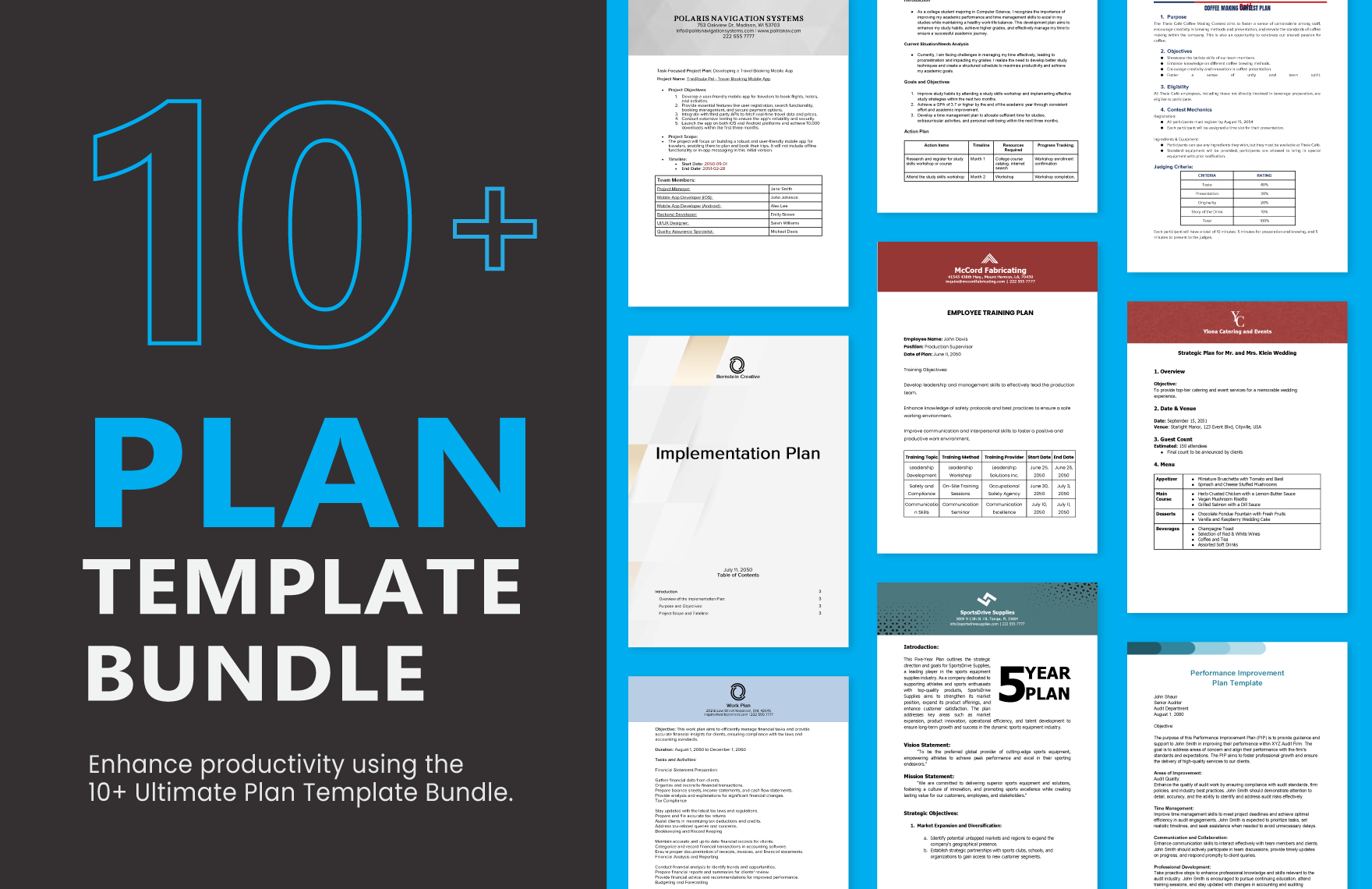
- Google Docs
Essay Plan Template

Modern History Essay Plan Template

Argumentative Essay Planning Sheet
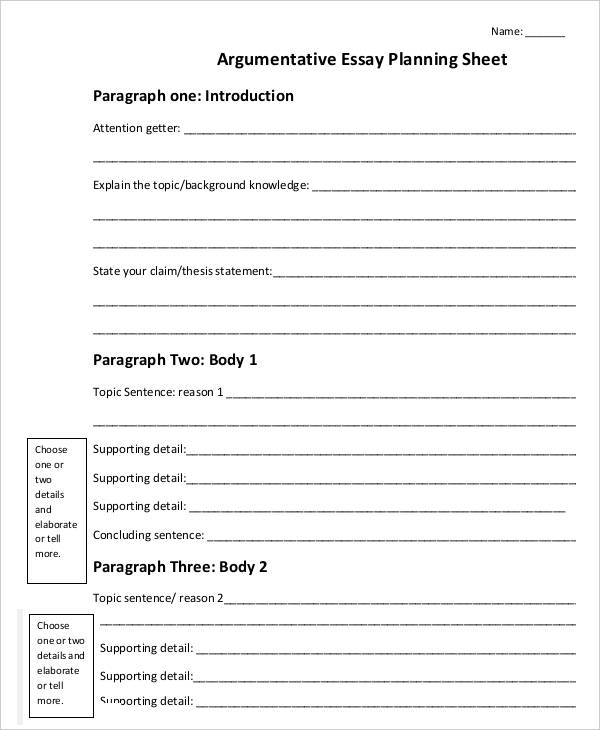
Law Essay Plan
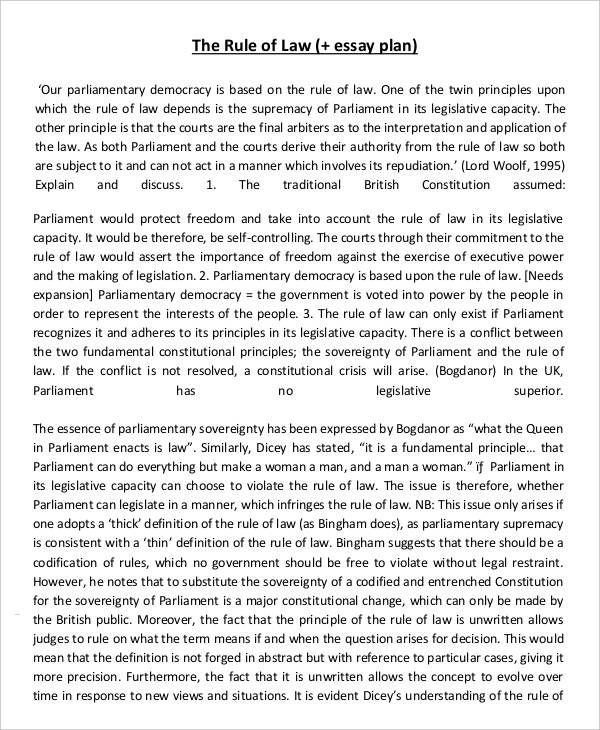
Short Course Essay Plan
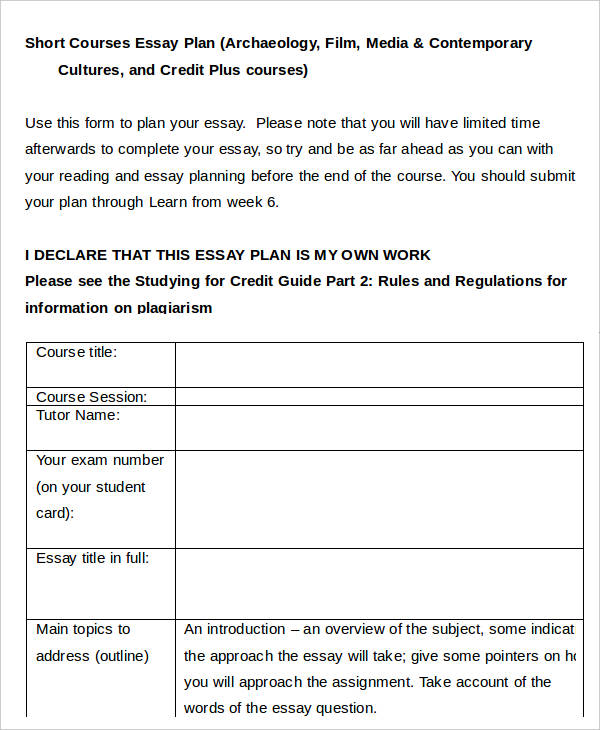
Academic Essay Plan
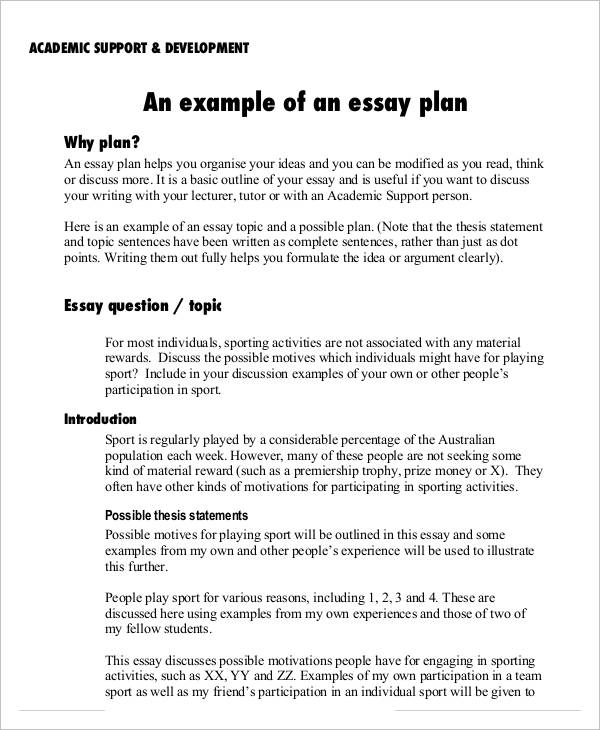
College Essay Plan
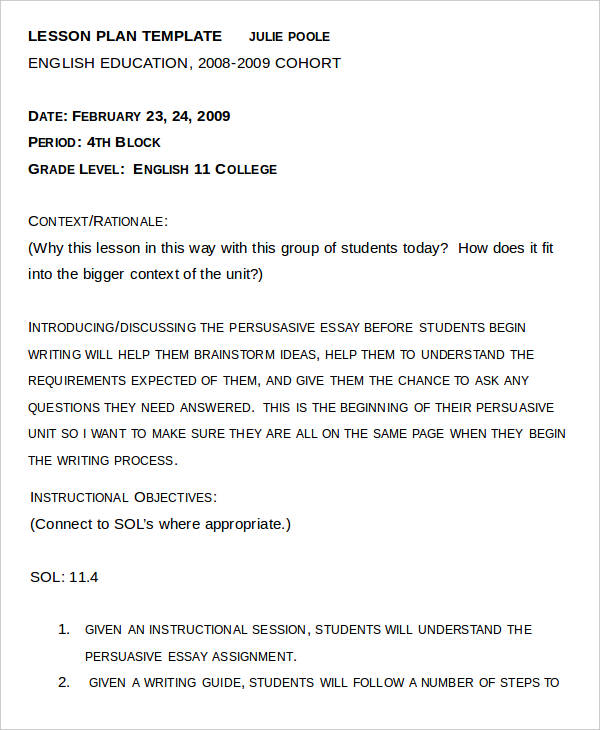
What Essay Plan Templates Are in Store for You?
- Argumentative Essay Planning Sheet Template – In writing an argumentative essay, the challenge lies on how you structure the flow of your arguments. Bear in mind that you can’t just merely enumerate your arguments but to lay them out in a logical and systematic manner. By using these template, you can breakdown your arguments into sections with their supporting details.
- Academic Essay Plan Template – This template is a guide in writing an effective essay plan. This will help you know the basic elements of an essay plan and how to effectively convey and write your ideas in the most comprehensible and coherent way. There are also sample thesis statements that you may refer to.
- Discursive Essay Plan Template – This template provides you with suggestions and outline on how to write an essay plan for three different types of discursive essays namely the for and against essays, opinion essays, and essays suggesting solutions to problems. The respective plan templates provide you with writing tips in terms of structure and content.
- Persuasive Plan Template – Persuasive essays can be tricky. Your essay must be convincing enough to persuade your readers to take your side. You need to effectively introduce the issue, clearly state your position, and write your supporting evidences.
Discursive Essay Plan
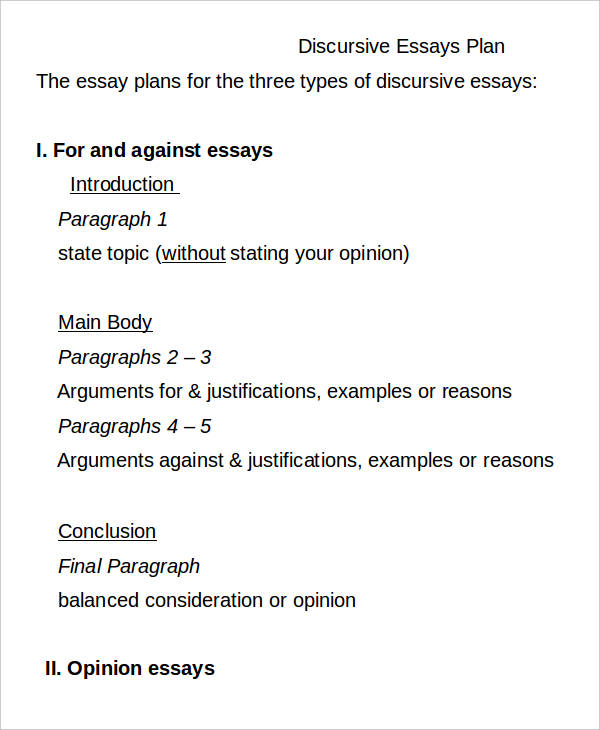
Persuasive Essay Plan
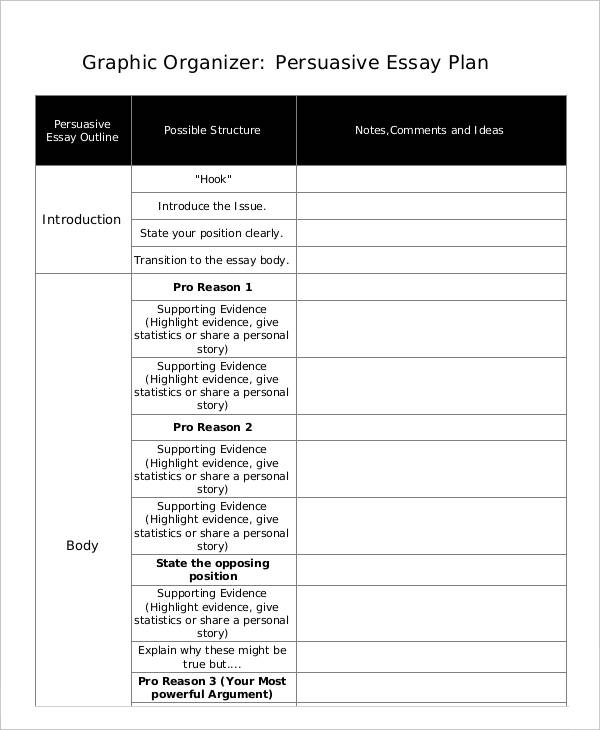
How to Effectively Map Out Your Essay Plan?
- Come up with a comprehensive and engaging thesis statement. You thesis statement presents the why’s and importance of your essay. It will be the heart of your essay. Your thesis statement will project the scope and limits of your the write-up. As per content, thesis statements are not necessarily long. As much as possible be concise and succinct.
- Provide topic sentences for each paragraph. This is done so as to guide the flow of your sentences. The topic sentence will is either your idea or argument. After that, substantiate your claims by providing your evidences.
- Make a sound conclusion. You also need to plan the structure of your conclusion. You should plan how you’ll manage to reiterate the important points and adding a strong closing sentences or notes to your reader’s in a creative and professional way. Like writing a strategic plan template , essay plan also provides key writing strategies and methods.
More in Plan Templates
Simple essay plan template, professional student interview essay template, biography essay template, descriptive writing essay template, short descriptive essay template, descriptive essay template, academic writing essay template, academic text example essay template, academic essay template, self reflective essay template.
- 7+ Financial Plan Templates
- 10+ Operational Plan Templates
- 9+ Training Plan Templates
- 5+ Shooting Schedule Template
- 11+ School Counselor Lesson Plan Templates in PDF | Word
- 9+ Interdisciplinary Lesson Plan Templates in PDF | MS Word
- 10+ Business Continuity Plan Templates in Google Docs | Ms Word | Pages | PDF
- 18+ Compensation Plan Templates in Google Docs | MS Word | Pages | PDF
- 10+ Executive Bonus Plan Templates in PDF
- 8+ Facility Management Plan Templates in PDF
- 10+ Diversity Recruitment Plan Templates in PDF | MS Word
- 11+ Audit Corrective Action Plan Templates in MS Word | Excel | PDF
- 9+ Recruitment Agency Marketing Plan Templates in PDF
- 10+ Recruitment Marketing Plan Templates in PDF | MS Word
- 10+ Student Recruitment Plan Templates in PDF | MS Word
File Formats
Word templates, google docs templates, excel templates, powerpoint templates, google sheets templates, google slides templates, pdf templates, publisher templates, psd templates, indesign templates, illustrator templates, pages templates, keynote templates, numbers templates, outlook templates.
Have a language expert improve your writing
Run a free plagiarism check in 10 minutes, generate accurate citations for free.
- Knowledge Base
- How to write an argumentative essay | Examples & tips
How to Write an Argumentative Essay | Examples & Tips
Published on July 24, 2020 by Jack Caulfield . Revised on July 23, 2023.
An argumentative essay expresses an extended argument for a particular thesis statement . The author takes a clearly defined stance on their subject and builds up an evidence-based case for it.
Instantly correct all language mistakes in your text
Upload your document to correct all your mistakes in minutes

Table of contents
When do you write an argumentative essay, approaches to argumentative essays, introducing your argument, the body: developing your argument, concluding your argument, other interesting articles, frequently asked questions about argumentative essays.
You might be assigned an argumentative essay as a writing exercise in high school or in a composition class. The prompt will often ask you to argue for one of two positions, and may include terms like “argue” or “argument.” It will frequently take the form of a question.
The prompt may also be more open-ended in terms of the possible arguments you could make.
Argumentative writing at college level
At university, the vast majority of essays or papers you write will involve some form of argumentation. For example, both rhetorical analysis and literary analysis essays involve making arguments about texts.
In this context, you won’t necessarily be told to write an argumentative essay—but making an evidence-based argument is an essential goal of most academic writing, and this should be your default approach unless you’re told otherwise.
Examples of argumentative essay prompts
At a university level, all the prompts below imply an argumentative essay as the appropriate response.
Your research should lead you to develop a specific position on the topic. The essay then argues for that position and aims to convince the reader by presenting your evidence, evaluation and analysis.
- Don’t just list all the effects you can think of.
- Do develop a focused argument about the overall effect and why it matters, backed up by evidence from sources.
- Don’t just provide a selection of data on the measures’ effectiveness.
- Do build up your own argument about which kinds of measures have been most or least effective, and why.
- Don’t just analyze a random selection of doppelgänger characters.
- Do form an argument about specific texts, comparing and contrasting how they express their thematic concerns through doppelgänger characters.
Receive feedback on language, structure, and formatting
Professional editors proofread and edit your paper by focusing on:
- Academic style
- Vague sentences
- Style consistency
See an example

An argumentative essay should be objective in its approach; your arguments should rely on logic and evidence, not on exaggeration or appeals to emotion.
There are many possible approaches to argumentative essays, but there are two common models that can help you start outlining your arguments: The Toulmin model and the Rogerian model.
Toulmin arguments
The Toulmin model consists of four steps, which may be repeated as many times as necessary for the argument:
- Make a claim
- Provide the grounds (evidence) for the claim
- Explain the warrant (how the grounds support the claim)
- Discuss possible rebuttals to the claim, identifying the limits of the argument and showing that you have considered alternative perspectives
The Toulmin model is a common approach in academic essays. You don’t have to use these specific terms (grounds, warrants, rebuttals), but establishing a clear connection between your claims and the evidence supporting them is crucial in an argumentative essay.
Say you’re making an argument about the effectiveness of workplace anti-discrimination measures. You might:
- Claim that unconscious bias training does not have the desired results, and resources would be better spent on other approaches
- Cite data to support your claim
- Explain how the data indicates that the method is ineffective
- Anticipate objections to your claim based on other data, indicating whether these objections are valid, and if not, why not.
Rogerian arguments
The Rogerian model also consists of four steps you might repeat throughout your essay:
- Discuss what the opposing position gets right and why people might hold this position
- Highlight the problems with this position
- Present your own position , showing how it addresses these problems
- Suggest a possible compromise —what elements of your position would proponents of the opposing position benefit from adopting?
This model builds up a clear picture of both sides of an argument and seeks a compromise. It is particularly useful when people tend to disagree strongly on the issue discussed, allowing you to approach opposing arguments in good faith.
Say you want to argue that the internet has had a positive impact on education. You might:
- Acknowledge that students rely too much on websites like Wikipedia
- Argue that teachers view Wikipedia as more unreliable than it really is
- Suggest that Wikipedia’s system of citations can actually teach students about referencing
- Suggest critical engagement with Wikipedia as a possible assignment for teachers who are skeptical of its usefulness.
You don’t necessarily have to pick one of these models—you may even use elements of both in different parts of your essay—but it’s worth considering them if you struggle to structure your arguments.
Regardless of which approach you take, your essay should always be structured using an introduction , a body , and a conclusion .
Like other academic essays, an argumentative essay begins with an introduction . The introduction serves to capture the reader’s interest, provide background information, present your thesis statement , and (in longer essays) to summarize the structure of the body.
Hover over different parts of the example below to see how a typical introduction works.
The spread of the internet has had a world-changing effect, not least on the world of education. The use of the internet in academic contexts is on the rise, and its role in learning is hotly debated. For many teachers who did not grow up with this technology, its effects seem alarming and potentially harmful. This concern, while understandable, is misguided. The negatives of internet use are outweighed by its critical benefits for students and educators—as a uniquely comprehensive and accessible information source; a means of exposure to and engagement with different perspectives; and a highly flexible learning environment.
The body of an argumentative essay is where you develop your arguments in detail. Here you’ll present evidence, analysis, and reasoning to convince the reader that your thesis statement is true.
In the standard five-paragraph format for short essays, the body takes up three of your five paragraphs. In longer essays, it will be more paragraphs, and might be divided into sections with headings.
Each paragraph covers its own topic, introduced with a topic sentence . Each of these topics must contribute to your overall argument; don’t include irrelevant information.
This example paragraph takes a Rogerian approach: It first acknowledges the merits of the opposing position and then highlights problems with that position.
Hover over different parts of the example to see how a body paragraph is constructed.
A common frustration for teachers is students’ use of Wikipedia as a source in their writing. Its prevalence among students is not exaggerated; a survey found that the vast majority of the students surveyed used Wikipedia (Head & Eisenberg, 2010). An article in The Guardian stresses a common objection to its use: “a reliance on Wikipedia can discourage students from engaging with genuine academic writing” (Coomer, 2013). Teachers are clearly not mistaken in viewing Wikipedia usage as ubiquitous among their students; but the claim that it discourages engagement with academic sources requires further investigation. This point is treated as self-evident by many teachers, but Wikipedia itself explicitly encourages students to look into other sources. Its articles often provide references to academic publications and include warning notes where citations are missing; the site’s own guidelines for research make clear that it should be used as a starting point, emphasizing that users should always “read the references and check whether they really do support what the article says” (“Wikipedia:Researching with Wikipedia,” 2020). Indeed, for many students, Wikipedia is their first encounter with the concepts of citation and referencing. The use of Wikipedia therefore has a positive side that merits deeper consideration than it often receives.
An argumentative essay ends with a conclusion that summarizes and reflects on the arguments made in the body.
No new arguments or evidence appear here, but in longer essays you may discuss the strengths and weaknesses of your argument and suggest topics for future research. In all conclusions, you should stress the relevance and importance of your argument.
Hover over the following example to see the typical elements of a conclusion.
The internet has had a major positive impact on the world of education; occasional pitfalls aside, its value is evident in numerous applications. The future of teaching lies in the possibilities the internet opens up for communication, research, and interactivity. As the popularity of distance learning shows, students value the flexibility and accessibility offered by digital education, and educators should fully embrace these advantages. The internet’s dangers, real and imaginary, have been documented exhaustively by skeptics, but the internet is here to stay; it is time to focus seriously on its potential for good.
If you want to know more about AI tools , college essays , or fallacies make sure to check out some of our other articles with explanations and examples or go directly to our tools!
- Ad hominem fallacy
- Post hoc fallacy
- Appeal to authority fallacy
- False cause fallacy
- Sunk cost fallacy
College essays
- Choosing Essay Topic
- Write a College Essay
- Write a Diversity Essay
- College Essay Format & Structure
- Comparing and Contrasting in an Essay
(AI) Tools
- Grammar Checker
- Paraphrasing Tool
- Text Summarizer
- AI Detector
- Plagiarism Checker
- Citation Generator
An argumentative essay tends to be a longer essay involving independent research, and aims to make an original argument about a topic. Its thesis statement makes a contentious claim that must be supported in an objective, evidence-based way.
An expository essay also aims to be objective, but it doesn’t have to make an original argument. Rather, it aims to explain something (e.g., a process or idea) in a clear, concise way. Expository essays are often shorter assignments and rely less on research.
At college level, you must properly cite your sources in all essays , research papers , and other academic texts (except exams and in-class exercises).
Add a citation whenever you quote , paraphrase , or summarize information or ideas from a source. You should also give full source details in a bibliography or reference list at the end of your text.
The exact format of your citations depends on which citation style you are instructed to use. The most common styles are APA , MLA , and Chicago .
The majority of the essays written at university are some sort of argumentative essay . Unless otherwise specified, you can assume that the goal of any essay you’re asked to write is argumentative: To convince the reader of your position using evidence and reasoning.
In composition classes you might be given assignments that specifically test your ability to write an argumentative essay. Look out for prompts including instructions like “argue,” “assess,” or “discuss” to see if this is the goal.
Cite this Scribbr article
If you want to cite this source, you can copy and paste the citation or click the “Cite this Scribbr article” button to automatically add the citation to our free Citation Generator.
Caulfield, J. (2023, July 23). How to Write an Argumentative Essay | Examples & Tips. Scribbr. Retrieved April 3, 2024, from https://www.scribbr.com/academic-essay/argumentative-essay/
Is this article helpful?

Jack Caulfield
Other students also liked, how to write a thesis statement | 4 steps & examples, how to write topic sentences | 4 steps, examples & purpose, how to write an expository essay, "i thought ai proofreading was useless but..".
I've been using Scribbr for years now and I know it's a service that won't disappoint. It does a good job spotting mistakes”

IMAGES
VIDEO
COMMENTS
Learn how to plan an essay with a linear bullet point plan, a list, a mind map, or a flow-diagram. Find out how to capture your ideas, group them, and adapt your plan as you write. See examples of essay plans and tips for feedback and structure.
To sum up, here are the 7 steps to essay planning one more time: The 7-Step Guide for How to Write an Essay Plan. Figure out your Essay Topic (5 minutes) Gather your Sources and take Quick Notes (20 minutes) Brainstorm using a Mind-Map (10 minutes) Arrange your Topics (2 minutes) Write your topic Sentences (5 minutes)
Revised on July 23, 2023. An essay outline is a way of planning the structure of your essay before you start writing. It involves writing quick summary sentences or phrases for every point you will cover in each paragraph, giving you a picture of how your argument will unfold. You'll sometimes be asked to submit an essay outline as a separate ...
The basic structure of an essay always consists of an introduction, a body, and a conclusion. But for many students, the most difficult part of structuring an essay is deciding how to organize information within the body. This article provides useful templates and tips to help you outline your essay, make decisions about your structure, and ...
As you draft and write your essay, record any changes on the plan as well as in the essay itself, so they develop side by side. One way to start planning an essay is with a 'box plan'. ... For example, say the assignment is "Discuss how media can influence children. Use specific examples to support your views. Word count: 1200."
This essay begins by discussing the situation of blind people in nineteenth-century Europe. It then describes the invention of Braille and the gradual process of its acceptance within blind education. Subsequently, it explores the wide-ranging effects of this invention on blind people's social and cultural lives.
Here is an example of an essay topic and a possible plan. (Note that the thesis statement and topic sentences have been written as complete sentences, rather than just as dot points. Writing them out fully helps you formulate the idea or argument clearly). Essay question / topic. For most individuals, sporting activities are not associated with ...
Organize evidence, strengthen supporting arguments, and hammer your main point home with our essay planning sheet. Create flow: Maintain a cohesive writing process with an essay planning template that clarifies how one section leads to the next. Evaluate your argument from all sides: Crystallize your claim and test it out from new angles in a ...
Make a plan. Planning your essay makes it more likely that you have a coherent argument. It enables you to work out a logical structure and an endpoint for your argument before you start writing. It means you don't have to do this type of complex thinking at the same time as trying to find the right words to express your ideas.
In a 1000-1500 word essay, aim for three to four main points; In the initial plan, try to express the main idea of each point in a single, clear sentence. These can become topic sentences—usually the first sentence of each paragraph which summarise the information in the paragraph. In your second plan, you develop these points further.
An essay outline template is essentially the essay plan. It provides students with a clear structure before they write their essay, including all of the main points that are necessary for their writing. Planning an essay outline beforehand makes the process of essay writing a lot less daunting, providing students with a guideline to follow ...
An essay outline is your essay plan and a roadmap to essay writing. It is the structure of an essay you are about to write. It includes all the main points you have to discuss in each section along with the thesis statement. ... Here are some examples of essay outlines for different grade levels. Essay outline 4th grade. Essay outline 5th grade ...
Essay Plan Example. Let's create an example essay plan using the planning sheet we previously discussed. First, if you don't already have an essay topic or thesis, take the time to choose one. For this example, we'll use the topic "intercultural awareness." Your first step in the writing process would be to research intercultural awareness.
10 Steps for Essay Planning. Read and analyze the essay questions. Write down the essay questions. Brainstorm or think of more ideas regarding the matter. List down all of your thoughts and the scope that covers the essay questions. Take note of the words or phrases that you think are essential in your work.
A step-by-step guide to filling in the essay plan. If the essay plan template looks daunting then don't worry, try breaking it down into stages: 1. Interpret and rephrase the essay question. You'll see that the first stage of the essay plan asks you to 'engage with the essay question'.
If all four topics are of equal importance, write roughly the same amount of words on each. If a topic is more important, write about it first and write more words on it. If a topic is less important, write about it last and write fewer words on it. Topic 1: scientific research. Topic 2: government agency reports.
Essay planning step 2: Brainstorming or freewriting. Once you know how many ideas you need, the next step is writing down what you know (and what you still have to find out). There are many ways that this can be achieved. You can either create a mind map, or just write out all your ideas on a piece of paper.
The structure of your expository essay will vary according to the scope of your assignment and the demands of your topic. It's worthwhile to plan out your structure before you start, using an essay outline. A common structure for a short expository essay consists of five paragraphs: An introduction, three body paragraphs, and a conclusion.
If all four topics are of equal importance, write roughly the same amount of words on each. If a topic is more important, write about it first and write more words on it. If a topic is less important, write about it last and write fewer words on it. Topic 1: workers Topic 2: peasants Topic 3: soldiers Topic 4: national minorities Conclusion (10 ...
Sample College Essay 2 with Feedback. This content is licensed by Khan Academy and is available for free at www.khanacademy.org. College essays are an important part of your college application and give you the chance to show colleges and universities your personality. This guide will give you tips on how to write an effective college essay.
Introduction: Every essay needs an introduction (3-5 sentences), so at the top of your essay plan just jot down introduction or intro, so you remember to write one. Paragraphs: Every essay must be written in paragraphs. Each paragraph should explain one main idea, and needs to have the SEXI structure: S: A Topic S entence.
Planning is not just crucial in terms of writing simple business plan template and personal development plan templates. Essays are also good subject matters in applying the right planning techniques. Argumentative Essay Planning Sheet Template - In writing an argumentative essay, the challenge lies on how you structure the flow of your arguments.
Examples of argumentative essay prompts. At a university level, all the prompts below imply an argumentative essay as the appropriate response. Your research should lead you to develop a specific position on the topic. The essay then argues for that position and aims to convince the reader by presenting your evidence, evaluation and analysis.
Access the Worksheet and Directions in Word (25 KB) and Worksheet and Directions in PDF (157 KB). Plan-Do-Study-Act Directions and Examples. The Plan-Do-Study-Act (PDSA) method is a way to test a change that is implemented. Going through the prescribed four steps guides the thinking process into breaking down the task into steps and then evaluating the outcome, improving on it, and testing again.